![]() FS 106 Nude female figure upside down with thighs drawn apart
FS 106 Nude female figure upside down with thighs drawn apartand a crab (?) issuing from her womb: two tigers standing face to face rearing on the ir hindlegs at L.
![]() FS 107 Drummer and a tiger.
FS 107 Drummer and a tiger.
![]() FS 108 Person kneeling under a kino tree facing a tiger
FS 108 Person kneeling under a kino tree facing a tiger
![]() FS 109 (Frequency of occurrence in M Corpus:5) Pcrson seated on a machan on a kino tree; a tiger below looking up at him/her.
FS 109 (Frequency of occurrence in M Corpus:5) Pcrson seated on a machan on a kino tree; a tiger below looking up at him/her.
![]() FS 111 (Frequency of occurrence in M Corpus: 3) From R.-a woman with outstretched arms flanked by two men holding uprooted trees fn their hands: a person seated on a tree wit h a tiger below: a tall jar with a lid.
FS 111 (Frequency of occurrence in M Corpus: 3) From R.-a woman with outstretched arms flanked by two men holding uprooted trees fn their hands: a person seated on a tree wit h a tiger below: a tall jar with a lid.
![]()
Molded terracotta tablet (H2001-5075/2922-01) with a narrative scene of a man in a tree with a tiger looking back over its shoulder. The tablet, found in the Trench 54 area on the west side of Mound E, is broken, but was made with the same mold as ones found on the eastern side of Mound E and also in other parts of the site (see slide 89 for the right hand portion of the same scene). The reverse of the same molded terra cotta tablet shows a deity grappling with two tigers and standing above an elephant (see slide 90 for a clearer example from the same mold). https://www.harappa.com/indus3/185.html heraka 'spy' rebus: eraka 'moltencast copper' kuTi 'tree' rebus:kuThi 'smelter' karA 'crocodile' rebus: khAr 'blacksmith' barad 'bull' rebus: baraDo 'alloy of pewter, copper, tin'.
Cluster 7 A metallurgical process narrative in four clusters -- four sides of a tablet:
Side 1.Tiger looks back, person on tree.
Side 2 Row of animals in file (a one-horned bull, an elephant and a rhinoceros from right); a gharial with a fish held in its jaw above the animals; a bird (?) at right.
Side 3. a person holding a vessel; a woman with a platter (?); a kneeling person with a staff in his hands facing the woman; a goat with its forelegs on a platform under a tree. [Or, two antelopes flanking a tree on a platform, with one antelope looking backwards?]
Side 4. Bos indicus, zebu
FS 116 One side of 4-sided tablet Mohenjodaro m1431. From R. - A person holding a vessel; a woman with a plallet; a kneeling person with a staff in his hands facing the woman; a goat with its forelegs on a platform under a kino tree.
The following glyphics of m1431 prism tablet show the association between the tiger + person on tree glyphic set and crocile + 3 animal glyphic set.
Mohenjo-daro m1431 four-sided tablet. Row of animals in file (a one-horned bull, an elephant and a rhinoceros from right); a gharial with a fish held in its jaw above the animals; a bird (?) at right. Pict-116: From R.—a person holding a vessel; a woman with a platter (?); a kneeling person with a staff in his hands facing the woman; a goat with its forelegs on a platform under a tree. [Or, two antelopes flanking a tree on a platform, with one antelope looking backwards?]
One side (m1431B) of a four-sided tablet shows a procession of a tiger, an elephant and a rhinoceros (with fishes (or perhaps, crocodile) on top?).
kāru ‘crocodile’ (Telugu). Rebus: artisan (Marathi) Rebus: khar ‘blacksmith’ (Kashmiri)
kola ‘tiger’ Rebus: kol ‘working in iron’. Heraka ‘spy’ Rebus: eraka ‘copper’. khōṇḍa ‘leafless tree’ (Marathi). Rebus: kõdār’turner’ (Bengali) dhamkara 'leafless tree' Rebus: dhangar 'blacksmith'
Looking back: krammara ‘look back’ Rebus: kamar ‘smith, artisan’.
koḍe ‘young bull’ (Telugu) खोंड [ khōṇḍa ] m A young bull, a bullcalf. Rebus: kõdā ‘to turn in a lathe’ (B.) कोंद kōnda ‘engraver, lapidary setting or infixing gems’ (Marathi) कोंडण [kōṇḍaṇa] f A fold or pen. (Marathi) ayakāra ‘ironsmith’ (Pali)[fish = aya (G.); crocodile = kāru (Te.)] baṭṭai quail (N.Santali) Rebus: bhaṭa = an oven, kiln, furnace (Santali) bhástrā f. ʻ leathern bag ʼ ŚBr., ʻ bellows ʼ Kāv., bhastrikā -- f. ʻ little bag ʼ Daś. [Despite EWA ii 489, not from a √bhas ʻ blow ʼ (existence of which is very doubtful). -- Basic meaning is ʻ skin bag ʼ (cf. bakura<-> ʻ bellows ʼ ~ bākurá -- dŕ̊ti -- ʻ goat's skin ʼ), der. from bastá -- m. ʻ goat ʼ RV. (cf.bastājina -- n. ʻ goat's skin ʼ MaitrS. = bāstaṁ carma Mn.); with bh -- (and unexpl. -- st -- ) in Pa. bhasta -- m. ʻ goat ʼ, bhastacamma -- n. ʻ goat's skin ʼ. Phonet. Pa. and all NIA. (except S. with a) may be < *bhāsta -- , cf. bāsta -- above (J. C. W.)]With unexpl. retention of -- st -- : Pa. bhastā -- f. ʻ bellows ʼ (cf. vāta -- puṇṇa -- bhasta -- camma -- n. ʻ goat's skin full ofwind ʼ), biḷāra -- bhastā -- f. ʻ catskin bag ʼ, bhasta -- n. ʻ leather sack (for flour) ʼ; K. khāra -- basta f. ʻ blacksmith's skin bellows ʼ; -- S. bathī f. ʻ quiver ʼ (< *bhathī); A. Or. bhāti ʻ bellows ʼ, Bi. bhāthī, (S of Ganges) bhã̄thī; OAw. bhāthā̆ ʻ quiver ʼ; H. bhāthā m. ʻ quiver ʼ, bhāthī f. ʻ bellows ʼ; G. bhāthɔ,bhātɔ, bhāthṛɔ m. ʻ quiver ʼ (whence bhāthī m. ʻ warrior ʼ); M. bhātā m. ʻ leathern bag, bellows, quiver ʼ, bhātaḍ n. ʻ bellows, quiver ʼ; <-> (X bhráṣṭra -- ?) N. bhã̄ṭi ʻ bellows ʼ, H. bhāṭhī f.OA. bhāthi ʻ bellows ʼ AFD 206.(CDIAL 9424)
ayo 'fish' Rebus: ayas 'metal'. kaṇḍa 'arrow' Rebus: khāṇḍa ‘tools, pots and pans, and metal-ware’. ayaskāṇḍa is a compounde word attested in Panini. The compound or glyphs of fish + arrow may denote metalware tools, pots and pans.kola 'tiger' Rebus: kol 'working in iron, alloy of 5 metals - pancaloha'. ibha 'elephant' Rebus ibbo 'merchant'; ib ‘iron'. Alternative: కరటి [ karaṭi ] karaṭi. [Skt.] n. An elephant. ఏనుగు (Telugu) Rebus: kharādī ‘ turner’ (Gujarati) kāṇḍa 'rhimpceros' Rebus: khāṇḍa ‘tools, pots and pans, and metal-ware’. The text on m0489 tablet: loa 'ficus religiosa' Rebus: loh 'copper'. kolmo 'rice plant' Rebus: kolami 'smithy, forge'. dula 'pair' Rebus: dul 'cast metal'. Thus the display of the metalware catalog includes the technological competence to work with minerals, metals and alloys and produce tools, pots and pans. The persons involved are krammara 'turn back' Rebus: kamar 'smiths, artisans'. kola 'tiger' Rebus: kol 'working in iron, working in pancaloha alloys'. పంచలోహము pancha-lōnamu. n. A mixed metal, composed of five ingredients, viz., copper, zinc, tin, lead, and iron (Telugu). Thus, when five svastika hieroglyphs are depicted, the depiction is of satthiya 'svastika' Rebus: satthiya 'zinc' and the totality of 5 alloying metals of copper, zinc, tin, lead and iron.
Glyph: Animals in procession: खांडा [khāṇḍā] A flock (of sheep or goats) (Marathi) கண்டி¹ kaṇṭi Flock, herd (Tamil) Rebus: khāṇḍā ‘tools, pots and pans, and metal-ware’.
Hieroglyph: heraka ‘spy’. Rebus: eraka, arka 'copper, gold'; eraka 'moltencast, metal infusion'; era ‘copper’. āra 'spokes' Rebus: āra 'brass'. Hieroglyph: हेर [ hēra ] m (हेरक S through or H) A spy, scout, explorator, an emissary to gather intelligence. 2 f Spying out or spying, surveying narrowly, exploring. (Marathi) *hērati ʻ looks for or at ʼ. 2. hēraka -- , °rika -- m. ʻ spy ʼ lex., hairika -- m. ʻ spy ʼ Hcar., ʻ thief ʼ lex. [J. Bloch FestschrWackernagel 149 ← Drav., Kuiēra ʻ to spy ʼ, Malt. ére ʻ to see ʼ, DED 765] 1. Pk. hēraï ʻ looks for or at ʼ (vihīraï ʻ watches for ʼ); K.ḍoḍ. hērūō ʻ was seen ʼ; WPah.bhad. bhal. he_rnū ʻ to look at ʼ (bhal. hirāṇū ʻ to show ʼ), pāḍ. hēraṇ, paṅ. hēṇā, cur. hērnā, Ku. herṇo, N. hernu, A. heriba, B. herā, Or. heribā (caus. herāibā), Mth. herab, OAw. heraï, H. hernā; G. hervũ ʻ to spy ʼ, M. herṇẽ. 2. Pk. hēria -- m. ʻ spy ʼ; Kal. (Leitner) "hériu"ʻ spy ʼ; G. herɔ m. ʻ spy ʼ, herũ n. ʻ spying ʼ. Addenda: *hērati: WPah.kṭg. (Wkc.) hèrnõ, kc. erno ʻ observe ʼ; Garh. hernu ʻ to look' (CDIAL 14165) Ko. er uk- (uky-) to play 'peeping tom'. Kui ēra (ēri-) to spy, scout; n. spying, scouting; pl action ērka (ērki-). ? Kuwi (S.) hēnai to scout; hēri kiyali to see; (Su. P.) hēnḍ- (hēṭ-) id. Kur. ērnā (īryas) to see, look, look at, look after, look for, wait for, examine, try; ērta'ānā to let see, show; ērānakhrnā to look at one another. Malt. ére to see, behold, observe; érye to peep, spy. Cf. 892 Kur. ēthrnā. / Cf. Skt. heraka- spy, Pkt. her- to look at or for, and many NIA verbs; Turner, CDIAL, no. 14165(DEDR 903)
Hieroglyph: ã̄gru sprout, rebus: aṅgar 'carbon element (to carburize moltencast, molten metal), charcoal' --: aṅkurá 1. ʻ *hooked ʼ. 2. m. ʻ sprout ʼ Uṇ., ʻ tumour ʼ Suśr. [*aṅku -- : √añc]1. Gy. as. agura ʻ crooked ʼ JGLS new ser. ii 331; Ash. áklə ʻ top of shoulder ʼ, Kt. ákři ʻ upper part of arm ʼ, Wg. akřá ʻ peg ʼ, Pr. uku ʻ shoulder ʼ; A. ã̄korā ʻ crooked, bent ʼ.2. Pa. aṅkura -- m. ʻ sprout ʼ, Pk. aṁkura -- m., N. ã̄kuro (lw. with k), B. Mth. ã̄kur; Or. āṅkuribā ʻ to cut off ears of ripe rice ʼ; H. ãkurā m. ʻ sprout ʼ, M. ã̄kūr m., ã̄krī f. ʻ tender spike of a tree ʼ; Si. akura, akara ʻ sprout, tumour ʼ.*aṅkurayati, *upāṅkura -- .Addenda: aṅkurá -- . 2. Garh. ã̄gru ʻ sprout ʼ, ãgryɔṇu ʻ to sprout ʼ.(CDIAL 109) Rebus: áṅgāra--: Niṅg. aṅgāˊr ʻ fire ʼ; Md. aguru ʻ charcoal ʼ. aṅgula-- [Cf. daśāṅgulá-- RV.](CDIAL14200) áṅgāra m. n. ʻ glowing charcoal ʼ RV., °aka -- lex. 2. *iṅgāra -- , iṅgāla -- m. Vāsav. com.1. Pa. aṅgāra -- m. ʻ charcoal ʼ, Pk. aṁgāra -- , °aya -- , aṁgāla -- , °aya -- m., Gy. eur. angár ʻ charcoal ʼ, wel. vaṅār m. (v -- from m. article), germ. yangar (y -- from yag, s.v. agní -- 1); Ash. aṅāˊ ʻ fire ʼ, Kt. aṅǻ, Gmb. aṅāˊ, Pr. anéye, Dm. aṅgar (a < ā NTS xii 130), Tir. Chilis Gau. K. nār (n < ṅ -- , not ← Psht. nār ← Ar. AO xii 184), Paš. aṅgāˊr, Shum. ã̄r (← Paš. NOGaw 59), Gaw. Kal. Kho. aṅgāˊr, Bshk. äṅgāˊr, Tor. aṅā, Mai. agār, Phal. aṅgṓr, Sh. agāˊr, ha° m.; S. aṅaru m. ʻ charcoal ʼ (a < ā as in Dm.), L. aṅgār m., P. aṅgyār, °rā m., EP. ãgeār (y or e from MIA. aggi < agní -- 1?), WPah. bhid. aṅgāˊrõ n., pl. -- ã, Ku. aṅār (ḍaṅār id. X ḍājṇo < dahyátē), N. aṅār, A. āṅgār, eṅgār, B. āṅgār, āṅrā, Or. aṅgāra; Bi. ãgarwāh ʻ man who cuts sugar -- cane into lengths for the mill ʼ (= pakwāh); OMth. aṁgāra, Mth. ãgor, H. ãgār, °rā m., G. ãgār, °rɔ m., M. ãgār m., Si. an̆gura. -- Wg. ãdotdot;ř, ã̄īˊ ʻ fire ʼ (as opp. to aṅarīˊk ʻ charcoal ʼ, see aṅgāryāˊ -- ) poss. < agní -- 1, Morgenstierne NTS xvii 226.
2. Pa. iṅghāḷa -- ʻ glowing embers (?) ʼ, Pk. iṁgāra -- , iṁgāla, °aya -- ; K. yĕngur m. ʻ charcoal ʼ, yĕnguru m. ʻ charcoal -- burner ʼ; M. ĩgaḷ, ĩgḷā m., Ko. ĩgḷo. -- Deriv. M. ĩgḷā m. ʻ a kind of large ant ʼ, ĩgḷī f. ʻ a large black deadly scorpion ʼ.aṅgāraka -- , aṅgāri -- , aṅgāryāˊ -- ; aṅgāradhānī -- , *aṅgāravarta -- , *aṅgārasthāna -- , *aṅgr̥ṣṭha -- .Addenda: áṅgāra -- : Md. an̆guru ʻ charcoal ʼ.aṅgāraka ʻ *red like embers ʼ, m. ʻ charcoal; name of various plants ʼ (aṅgārikā -- f. ʻ stalk of sugar -- cane, flower of Butea frondosa ʼ). 2. m. ʻ the planet Mars ʼ. [áṅgāra -- ]1. Pa. aṅgāraka -- ʻ red like charcoal ʼ; S. aṅārī f. ʻ smut in wheat ʼ; WPah. bhal. aṅāˊri f. ʻ a plant with red flowers ʼ.2. Pa. aṅgāraka -- m. ʻ Mars ʼ, Pk. aṁgāraya -- m.; S. aṅāro m. ʻ Tuesday ʼ.aṅgāradhānī -- , °ikā -- f. ʻ portable stove ʼ lex. [áṅgāra -- , dhāˊna -- ]Paš. aṅgarāˊn, aṅgaranīˊ ʻ fireplace *aṅgāravarta m. ʻ fire stone ʼ. [áṅgāra -- , *varta -- 3]Ash. aṅalawaṭ (r -- r > l -- r). *aṅgārasthāna n. ʻ fireplace ʼ. [áṅgāra -- , sthāˊna -- ]Dm. aṅgarthäĩ (perh. a Dm. cmpd.). -- See *agnisthāna -- .aṅgāri f., aṅgāritā -- f. ʻ portable brazier ʼ lex. [áṅgāra -- ]H. ãgārī f.Addenda: aṅgāri -- : †*aṅgāriṣṭha -- .130a †*aṅgāriṣṭha -- ʻ portable brazier ʼ. [aṅgāri -- , stha -- : cf. agniṣṭhá -- ]WPah.kṭg. garṭhɔ m. ʻ charcoal ʼ; J. gārṭhā m. ʻ a small burning coal ʼ.131 aṅgāryāˊ -- , *aṅgāriyā -- , f. ʻ heap of embers ʼ. [Cf. aṅgā- rīya -- ʻ fit for making charcoal ʼ, aṅgārikā -- f., angāritā -- f. ʻ portable fireplace ʼ lex.: áṅgāra -- ]Wg. aṅarīˊk, aṅgríč ʻ charcoal ʼ; Paš. aṅgerík ʻ black charcoal ʼ, Shum. ãdotdot;gerík; Phal. aṅgerīˊ ʻ charcoal ʼ, aṅgerīˊṣi f. ʻ black charcoal ʼ; Ku. aṅāri ʻ sparks ʼ; G. ãgārī f. ʻ small hearth with embers in it ʼ.(CDIAL 125 to 131). This signifies the carbon dhatu or carbon element which enters through godhuma, 'wheat chaff smoke' into the molten metal to harden it.![]() m1429 Three sided molded tablet. One side shows a flat bottomed boat with a central hut that has leafy fronds at the top of two poles. Two birds sit on the deck and a large double rudder extends from the rear of the boat. On the second side is a snout nosed gharial with a fish in its mouth. The third side has eight symbols of the Indus script.
m1429 Three sided molded tablet. One side shows a flat bottomed boat with a central hut that has leafy fronds at the top of two poles. Two birds sit on the deck and a large double rudder extends from the rear of the boat. On the second side is a snout nosed gharial with a fish in its mouth. The third side has eight symbols of the Indus script.
Material: terra cotta
Dimensions: 4.6 cm length, 1.2 x 1.5 cm width Mohenjo-daro, MD 602
Islamabad Museum, NMP 1384
Dales 1965a: 147, 1968: 39The large oxhide ingots were signified by ḍhālako a large metal ingot (Hieroglyph: dhāḷ 'a slope'; 'inclination' ḍhāla n. ʻ shield ʼ lex. 2. *ḍhāllā -- .1. Tir. (Leech) "dàl"ʻ shield ʼ, Bshk. ḍāl, Ku. ḍhāl, gng. ḍhāw, N. A. B. ḍhāl, Or. ḍhāḷa, Mth. H. ḍhāl m.2. Sh. ḍal (pl. °le̯) f., K. ḍāl f., S. ḍhāla, L. ḍhāl (pl. °lã) f., P. ḍhāl f., G. M. ḍhāl f.Addenda: ḍhāla -- . 2. *ḍhāllā -- : WPah.kṭg. (kc.) ḍhāˋl f. (obl. -- a) ʻ shield ʼ (a word used in salutation), J. ḍhāl f.(CDIAL 5583).
kāraṇḍava m. ʻ a kind of duck ʼ MBh. [Cf. kāraṇḍa- m. ʻ id. ʼ R., karēṭu -- m. ʻ Numidian crane ʼ lex.: see karaṭa -- 1]
Pa. kāraṇḍava -- m. ʻ a kind of duck ʼ; Pk. kāraṁḍa -- , °ḍaga -- , °ḍava -- m. ʻ a partic. kind of bird ʼ; S. kānero m. ʻ a partic. kind of water bird ʼ < *kāreno.(CDIAL 3059) करढोंक or की (p. 78) karaḍhōṅka or kī m करडोक m A kind of crane or heron (Marathi) kāraṇḍava m. ʻ a kind of duck ʼ MBh. [Cf. kāraṇḍa- m. ʻ id. ʼ R., karēṭu -- m. ʻ Numidian crane ʼ lex.: see karaṭa -- 1]
Pa. kāraṇḍava -- m. ʻ a kind of duck ʼ; Pk. kāraṁḍa -- , °ḍaga -- , °ḍava -- m. ʻ a partic. kind of bird ʼ; S. kānero m. ʻ a partic. kind of water bird ʼ < *kāreno.(CDIAL 3059) करढोंक or की (p. 78) karaḍhōṅka or kī m करडोक m A kind of crane or heron (Marathi)
![]() m1186 FS 114 From R. - a horned pe rsonage standing between the branches of a pipal trec: a low pedestal with some offerings: a horn ed personage kneeling in adoration; a ram;a row of seven robed figures in the lower register.
m1186 FS 114 From R. - a horned pe rsonage standing between the branches of a pipal trec: a low pedestal with some offerings: a horn ed personage kneeling in adoration; a ram;a row of seven robed figures in the lower register.
bahulā f. pl. ʻ the Pleiades ʼ VarBr̥S., °likā -- f. pl. lex. [bahulá -- ] Kal. bahul ʻ the Pleiades ʼ, Kho. ból, (Lor.) boul, bolh, Sh. (Lor.) b*lle.(CDIAL 9195) Rebus: baghla 'dhow, cargo boat'. ![]() FS 95
FS 95
Cluster 9 Bier cluster, wheelwright category
![]() FS 96 Person standing at the centre between a two-tiered
FS 96 Person standing at the centre between a two-tieredstructure at R. and a short·horned bull standing near a trident-headed post at L.
khaḍū1 m. ʻ bier ʼ lex. 2. khaṭṭi -- m. lex. [Cf. kháṭvā -- ] 1. B. khaṛu ʻ bier ʼ.2. B. khāṭi ʻ bier ʼ, Or. khāṭa.(CDIAL 3785) Rebus: khāti 'wheelwright'. Text of inscription: dula 'two' rebus: dul 'metalcasting' PLUSarā 'spoke of wheel' rebus: arā 'brass'. Hieroglyph:buffalo: rã̄go 'buffalo' Rebus: rāṅgā 'zinc alloy, spelter, pewter'. Thus, cast spelter Hieroglyph: body: mēd 'body' (Kur.)(DEDR 5099); meḍ 'iron' (Ho.)
Cluster 15 Tortoise, turtle clusters, bronze classifiers
![]()
![]() FS 69 Inscribed object in the shape of a tortoise.
FS 69 Inscribed object in the shape of a tortoise.![]() FS 56 (Frequency in M Corpus: 9) dula 'duplicated, mirror image' rebus: dul'metal casting' PLUS
FS 56 (Frequency in M Corpus: 9) dula 'duplicated, mirror image' rebus: dul'metal casting' PLUS
A giant turtle (of what was thought to be an extinct species) has been found on Pacific island in 2010 CE !!
कंस[p= 241,1] mn. ( √कम् Un2. iii , 62), a vessel made of metal , drinking vessel , cup , goblet AV. x , 10 , 5 AitBr. S3Br. &c; a metal , tutanag or white copper , brass , bell-metal
![]() "Front view of Meiolania platyceps fossil
"Front view of Meiolania platyceps fossil
The animal was rather large, measuring 2.5 metres (8.2 ft) in length, making it the second-largest known nonmarine turtle or tortoise, surpassed only by Colossochelys atlas from Asia, which lived in the Pleistocene. It lived in Australia and New Caledonia. Remains have also been found on the island of Efate in Vanuatu, associated with settlements from the Lapitaculture...When the first fossil remains (a vertebra) were found, they were originally thought to be from a large monitor lizard, similar to, but smaller than Megalania, so the genus was named accordingly. Later, when more remains were found, it was realized that the "small roamer" was actually a turtle, and not a lizard. Synonyms include Miolania and Ceratochelys."
There are examples of copper plates with the pictorial motifs of large turtles combined back to back, as a pair to signify: dula 'pair' rebus: dul 'metal casting'.
m1528Act
m1529Act2920
m1529Bct
m1532Act
m1532Bct
m1534Act
m1534Bct
1703 Composition:
Two horned heads one at either end of the body. Note the dottings on the thighs which is a unique artistic feature of depicting a turtles (the legs are like those of an elephant?). The body apparently is a combination of two turtles with heads of turtles emerging out of the shell and attached on either end of the composite body.
Copper tablet type B18, B17b. Tortoise with mirror duplicaes.
Hieroglyph: two large turtles joined back to back. Thus, signifying meta casting using cire perdue (lost-wax) technique of creating mirror image metal castings from wax casts.
The hieroglyph multiplex on m1534b is now read rebus as: dula 'pair' rebus: dul 'cast metal' PLUS kassa 'turtle' rebus: kãsā 'bell-metal' kamaṭha 'turtle' rebus: kãsā kammaṭa'bell-metal coiner, mint, portable furnace'.
kamaṭha crab, tortoise (Gujarati); ‘frog’ (Skt.); rebus: kammaṭa ‘mint’ (Kannada)kampaṭṭam ‘coiner, mint’ (Tamil).கமடம், [ *kamaṭam, ] s. A turtle, a tortoise, ஆமை (Winslow Tamil lexicon) కమఠము [ kamaṭhamu ] kamaṭhamu. [Skt.] n. A tortoise.
Rebus: కమటము [ kamaṭamu ] kamaṭamu. [Tel.] n. A portable furnace for melting the precious metals. అగసాలెవాని కుంపటి. Allograph: कमटा or ठा [ kamaṭā or ṭhā ] m (कमठ S) A bow (esp. of bamboo or horn) (Marathi). Allograph 2: kamaḍha ‘penance’ (Pkt.) Rebus: Ta. kampaṭṭam coinage, coin. Ma. kammaṭṭam, kammiṭṭam coinage, mint. Ka. kammaṭa id.; kammaṭi a coiner. (DEDR 1236)
m1532b On another copper tablet, the emphasis is clearly on the turtle's shell like that of Meiolania's shell.
On copper tablet m1543, the correct identification of the animal heads will be turtle species comparable to Meiolania, a horned large turtle of New Guinea.
Hieroglyph: kassa ‘turtle’: kacchapa m. ʻ turtle, tortoise ʼ MBh. 2. *kacchabha -- . [By pop. etym. through kaccha -- for kaśyápa -- VS. J. Charpentier MO xxvi 110 suggested equivalence in MIA. of kassa -- = kaccha -- to explain creation of kacchapa -- ~ kassapa -- . But K. kochuwu, unless a loan from Ind., points to *kakṣapa -- , which would make the formation earlier.] 1. Pa. kacchapa -- m. ʻ tortoise, turtle, °pinī -- f., Pk. kacchava -- m., °vī -- f., K. kochuwu m. (see above), S. kachãũ, °chū̃ m., L. kachū̃ m., P. kacchū, kacchūkummã̄ m. (< kūrmá -- 1), N. kachuwā, A. kācha, B. kāchim, Or. kechu, °cho, kẽchu, kaï˜cha, °ca, kachima, °cima, Mth. kāchu, Bhoj. Aw. lakh. kachuā; H. kachuā, °chwā m., °uī, °wī f. ʻ tortoise, turtle ʼ, kach -- mach m. ʻ dwellers in the water ʼ (< mátsya -- ) whence kacch, kach m. ʻ turtle, tortoise ʼ, M. kāsav, kã̄s° m., Ko. kāsavu. 2. Pk. amg. kacchabha -- , °aha -- m., °bhī -- f.; Si. käsum̆bu, °ubu H. Smith JA 1950, 188; -- G. kācbɔ m., °bī f. with unexpl. retention of -- b -- and loss of aspiration in c. Addenda: kacchapa -- . 1. A. kācha (phonet. -- s -- ) ʻ tortoise ʼ AFD 217. 2. *kacchabha -- (with -- pa -- replaced by animal suffix -- bha -- ): Md. kahan̆bu ʻ tortoise -- shell ʼ.(CDIAL 2619)
Rebus: OMarw. kāso (= kã̄ -- ?) m. ʻ bell -- metal tray for food, food.
kaṁsá1 m. ʻ metal cup ʼ AV., m.n. ʻ bell -- metal ʼ Pat. as in S., but would in Pa. Pk. and most NIA. lggs. collide with kāˊṁsya -- to which L. P. testify and under which the remaining forms for the metal are listed. 2. *kaṁsikā -- . 1. Pa. kaṁsa -- m. ʻ bronze dish ʼ; S. kañjho m. ʻ bellmetal ʼ; A. kã̄h ʻ gong ʼ; Or. kãsā ʻ big pot of bell -- metal ʼ; OMarw. kāso (= kã̄ -- ?) m. ʻ bell -- metal tray for food, food ʼ; G. kã̄sā m. pl. ʻ cymbals ʼ; -- perh. Woṭ. kasṓṭ m. ʻ metal pot ʼ Buddruss Woṭ 109. 2. Pk. kaṁsiā -- f. ʻ a kind of musical instrument ʼ; K. kanzü f. ʻ clay or copper pot ʼ; A. kã̄hi ʻ bell -- metal dish ʼ; G. kã̄śī f. ʻ bell -- metal cymbal ʼ, kã̄śiyɔ m. ʻ open bellmetal pan ʼ. kāˊṁsya -- ; -- *kaṁsāvatī -- ? Addenda: kaṁsá -- 1: A. kã̄h also ʻ gong ʼ or < kāˊṁsya -- . (CDIAL 2576) It is possible that the word in Tamil for ‘gold, money’ is cognate with these etyma of Indian sprachbund: காசு³ kācu , n. prob. kāš. cf. kāca. [M. kāšu.] 1. Gold; பொன். (ஆ. நி.) 2. Necklace of gold coins; அச்சுத்தாலி. காசும் பிறப்புங் கலகலப்ப (திவ். திருப்பா. 7). 3. An ancient gold coin = 28 gr. troy; ஒரு பழைய பொன்னாணயம். (Insc.) 4. A small copper coin;சிறுசெப்புக்காசு. நெஞ்சே யுனையோர் காசா மதியேன் (தாயு. உடல்பொய். 72). 5. Coin, cash, money; ரொக்கம். எப்பேர்ப்பட்ட பல காசா யங்களும் (S.I.I. i, 89). 6. Gem, crystal bead; மணி.நாண்வழிக் காசுபோலவும் (இறை. 2, உரை, பக். 29). 7. Girdle strung with gems; மேகலாபர ணம்.பட்டுடை சூழ்ந்த காசு (சீவக. 468). 8. (Pros.) A formula of a foot of two nēr acaiveṇpā; வெண்பாவின்இறுதிச்சீர்வாய்பாட்டுள் ஒன்று. (காரிகை, செய். 7.) 9. The hollow in the centre of each row of pallāṅkuḻi; பல்லாங்குழி யாட்டத்திற் காய்கள் சேர்தற்குரிய நடுக்குழிகள்.
1) కంచరవాడు (p. 224) kañcaravāḍu kanṭsu. n. Bell metal. కంచుకుండ a bowl or vessel or bell metal.కంచువాద్యము a cymbal made of bell metal. కంచుతీసినట్లు as...
2) కంచము (p. 223) kañcamu kanṭsamu. [Tel.] n. A metal plate or dish. కంచుకంచము a dish made of bell metal. మా కంచములో రాయి వేసినాడు he threw a stone into our place, i.e., took away our bread, he disturbed us. మందకంచము a dish which as a rim. ఆకుకంచము a dish which has none. 2) ) కంసర (p. 227) kaṃsara or కంసలల kamsara. [Tel.] n. Smithery; working in gold: adj. Of the goldsmith caste. కంసలది a woman of that caste. కంసలపని the business of a gold-smith. 3) కంసము (p. 227) kaṃsamu kamsamu. [Skt.] n. Bell metal.కంచు.
4) కాంస్యము (p. 265) kāṃsyamu kāmsyamu. [Skt.] n. Bell metal. కంచు. 4) కంసాలి (p. 227) kaṃsāli or కంసాలవాడు kamsāli. [Tel.] n. A goldsmith or silversmith. 5) కంచరవాడు (p. 224) kañcaravāḍu or కంచరి kanṭsara-vaḍu. [Tel.] n. A brazier, a coppersmith. కంచుపనిచేయువాడు. కంచరది a woman of that caste. కంచరిపురుగు kanṭsari-purugu. n. A kind of beetle called the death watch. కంచు kanṭsu. n. Bell metal. కంచుకుండ a bowl or vessel or bell metal. కంచువాద్యము a cymbal made of bell metal. కంచుతీసినట్లు as bright or dazzling as the glitter of polished metal. Sunbright.ఆమె కంచుగీచినట్లు పలికె she spoke shrilly or with a voice as clear as a bell. కాంచనము (p. 265) kāñcanamu kānchanamu. [Skt.] n. Gold. కాంచనవల్లి a piece of gold wire.కాంచనాంబరము tissue, gold cloth. Kāñcana काञ्चन a. (-नी f.) [काञ्च्-ल्युट्] Golden, made of gold; तन्मध्ये च स्फटिकफलका काञ्चनी वासयष्टिः Me.81; काञ्चनंवलयम् Ś.6.8; Ms.5.112. -नम् 1 Gold; समलोष्टाश्मकाञ्चनः Bg. 14.24. (ग्राह्यम्) अमेध्यादपि काञ्चनम् Ms.2.239. -2 Lustre, brilliancy. -3 Property, wealth, money. (Apte). kāñcaná ʻ golden ʼ MBh., n. ʻ gold ʼ Mn.Pa. kañcana -- n. ʻ gold ʼ, °aka -- ʻ golden ʼ; Pk. kaṁcaṇa<-> n. ʻ gold ʼ; Si. kasuna ʻ gold ʼ, kasun -- ʻ golden ʼ. (CDIAL 3013)காஞ்சனம்¹ kāñcaṉam , n. < kāñcana. Gold; பொன். (திவா.) కాంచనము (p. 265) kāñcanamu kānchanamu. [Skt.] n. Gold. కాంచనవల్లి a piece of gold wire. కాంచనాంబరము tissue, gold cloth. The hieroglyph multiplex on m1534b is now read rebus as: dula 'pair' rebus: dul 'cast metal' PLUS kassa 'turtle' rebus: kãsā 'bell-metal' kamaṭha 'turtle' rebus: kãsā kammaṭa
'bell-metal coiner, mint, portable furnace'.
Cluster 16 Seated person in penance, mint classifier
![]() FS 80 (Frequency in M Corpus:3) Horned personage seated on a pedestal.
FS 80 (Frequency in M Corpus:3) Horned personage seated on a pedestal.
![]() FS 81
FS 81
![]() FS 82 kamaḍha 'penance' Rebus: kammaṭa 'mint, coiner'; kaṇḍo 'stool, seat' Rebus: kāṇḍa 'metalware'
FS 82 kamaḍha 'penance' Rebus: kammaṭa 'mint, coiner'; kaṇḍo 'stool, seat' Rebus: kāṇḍa 'metalware'
Cluster 17 Archer cluster,mint classifier
![]() FS 89 (Frequency in M Corpus: 6) Standing personage with ho rns and bovine features holding a bow in one hand and an arrow or an uncertain object in the other.
FS 89 (Frequency in M Corpus: 6) Standing personage with ho rns and bovine features holding a bow in one hand and an arrow or an uncertain object in the other.
kamaṭha 'penance' Rebus: kammaṭa 'mint, coiner';
Cluster 18 ayakara 'metalsmith' cluster, alloy metal smithy, forge classifier
![]() FS 63
FS 63
![]() FS 64
FS 64
![]() FS 65
FS 65
![]() FS 66
FS 66
![]() FS 67 FS 63 to FS 67 Gharia1. sometimes with a fish held in its jaw and/ or surrounded by school of fish. (Frequency in M Corpus: 49)
FS 67 FS 63 to FS 67 Gharia1. sometimes with a fish held in its jaw and/ or surrounded by school of fish. (Frequency in M Corpus: 49)
![]() FS 68 Inscribed object in the shape of a fish (Frequency in M Corpus: 14) ayo 'fish' rebus: ayas 'alloy metal' अयस् n. iron , metal RV. &c; an iron weapon (as an axe , &c ) RV. vi , 3 ,5 and 47 , 10; gold (नैघण्टुक , commented on by यास्क);steel L. ; ([cf. Lat. aes , aer-is for as-is ; Goth. ais , Thema aisa ; Old Germ. e7r , iron ; Goth. eisarn ; Mod.Germ. Eisen.])
FS 68 Inscribed object in the shape of a fish (Frequency in M Corpus: 14) ayo 'fish' rebus: ayas 'alloy metal' अयस् n. iron , metal RV. &c; an iron weapon (as an axe , &c ) RV. vi , 3 ,5 and 47 , 10; gold (नैघण्टुक , commented on by यास्क);steel L. ; ([cf. Lat. aes , aer-is for as-is ; Goth. ais , Thema aisa ; Old Germ. e7r , iron ; Goth. eisarn ; Mod.Germ. Eisen.])
Cluster 19 Smelter cluster, wealth-category of smelted mineral ores
![]() FS 75
FS 75
![]() FS 76
FS 76
![]() FS 77 (Frequency of occurrence in M Corpus: 34) Kino tree generally within a railing or on a platform. kuṭi 'tree' rebus: kuṭhi 'smelter'
FS 77 (Frequency of occurrence in M Corpus: 34) Kino tree generally within a railing or on a platform. kuṭi 'tree' rebus: kuṭhi 'smelter'
Cluster 20 Magnetite, ferrite ore cluster wealth-category or wealth-classification
![]() FS 10 (Frequency in M Corpus 54) Bos indicus, zebu. Humped bull.
FS 10 (Frequency in M Corpus 54) Bos indicus, zebu. Humped bull.
Hieroglyph: पोळ pōḷa m A bull dedicated to the gods, marked with a trident and discus, and set at large. पोळी (p. 305) pōḷī fig. A dewlap. पोळी पिकणें g. of s. To begin to fare sumptuously; to get into good living. पोळा (p. 305) pōḷā m (पोळ) A festive day for cattle,--the day of new moon of श्रावण or of भाद्रपद. Bullocks are exempted from labor; variously daubed and decorated; and paraded about in worship.
Rebus: पोळ pōḷa 'magnetite, ferrite ore'. To burn: पोळभाज pōḷabhāja f (पोळणें & भाजणें To burn &c.) In agriculture. A comprehensive term for the operations connected with the burning of the ground.
Metal casting clusters (cire perdue, 'lost wax method')
![]() FS 14
FS 14
![]() FS 127 A large device in the upper register s howing a number of
FS 127 A large device in the upper register s howing a number ofsmall circles in three rows with ano the r row of short vertical lines below (identified as a 'seed-drill "!). I suggest that this is an orthographic representation of a bee-hive with horns and 'notches'. पोळ pōḷa n C (Or पोळें) A honeycomb PLUS koḍ 'horn' rebus: koḍ 'workshop' PLUS 'notches' hieroglyph: 'notch' hieroglyph: खांडा [ khāṇḍā ] m A jag, notch, or indentation (as upon the edge of a tool or weapon). (Marathi) Rebus: khāṇḍā 'tools, pots and pans, metal-ware'. Thus, pōḷa koḍ khāṇḍā 'haematite, ferrite ore workshop, metalware smelter.' (Alternative explanation of the field symbol: A large device in the upper register showing a number of small circles in three rows with another row of short vertical lines below (identified as a 'seed-drill "!)
![]() Sign 222 is
Sign 222 is![]() Sign 216 + notch (slanted stroke)Hieroglyph: katī 'blacksmith's goldsmith's scissors' rebus: khātī m. ʻ 'member of a caste of wheelwrights' PLUS 'notch' hieroglyph: खांडा [ khāṇḍā ] m A jag, notch, or indentation (as upon the edge of a tool or weapon)khāṇḍā 'tools, pots and pans, metal-ware'. (Marathi). Thus, khātī khāṇḍā 'wheelwright, equipment'
Sign 216 + notch (slanted stroke)Hieroglyph: katī 'blacksmith's goldsmith's scissors' rebus: khātī m. ʻ 'member of a caste of wheelwrights' PLUS 'notch' hieroglyph: खांडा [ khāṇḍā ] m A jag, notch, or indentation (as upon the edge of a tool or weapon)khāṇḍā 'tools, pots and pans, metal-ware'. (Marathi). Thus, khātī khāṇḍā 'wheelwright, equipment'
![]() Sign 254 if duplicated
Sign 254 if duplicated![]() Sign 86 (long linear stroke) koḍa 'one' rebus: koḍ 'workshop' dula 'two, duplicated' rebus: dul 'metal casting' PLUS 'three horizontal strokes' kolom 'three' rebus; kolimi 'smithy, forge'. Thus hypertext of Sign 254 reads: dul koḍ kolimi 'metal casting smithy, forge'
Sign 86 (long linear stroke) koḍa 'one' rebus: koḍ 'workshop' dula 'two, duplicated' rebus: dul 'metal casting' PLUS 'three horizontal strokes' kolom 'three' rebus; kolimi 'smithy, forge'. Thus hypertext of Sign 254 reads: dul koḍ kolimi 'metal casting smithy, forge'![]()
![]()
![]()
![]() The cluster of hypertexts in Text message of FS 127 reads:
The cluster of hypertexts in Text message of FS 127 reads:
ayo dhakka, ayo ḍhāḷako khātī khāṇḍā 'bright metal alloy, alloymetal large ingot, wheelwright, equipment' dul koḍ kolimi 'metal casting smithy, forge'.
Modifier on Sign 72: sloping stroke: ḍhāḷiyum = adj. sloping, inclining (G.) The ligatured glyph is read rebus as: ḍhālako = a large metal ingot (G.) ḍhālakī = a metal heated and poured into a mould; a solid piece of metal; an ingot (Gujarati).
The inscription hypertext of FS 127 reads: pōḷa koḍ khāṇḍā 'haematite, ferrite ore workshop, metalware smelter.' PLUS ayo dhakka, ayo ḍhāḷa khātī khāṇḍā 'bright metal alloy, alloymetal ingot, wheelwright, equipment' dul koḍ kolimi 'metal casting smithy, forge'.
It is an orthographic variant of a bee-hive. Hieroglyph: पोळ pōḷa n C (Or पोळें) A honeycomb. पोळें pōḷēṃ n C A cake-form or flat honeycomb. पोळा pōḷā m (पोळ) The cake-form portion of a honeycomb. 3 A kindled portion flying up from a burning mass, a flake. 4 C A nest of bees or of उंबील or हुरण (species of ant) formed on trees by doubling over and gluing together leaves. 5 C A portion of the दाढ (loppings and straw strewed over ground to be turned) remaining unburned. 6 C पोकळा or the flowers of शेगवा rolled up in a plantain-leaf and broiled over the fire. An eatable amongst children.
Cluster 21 Dhokra 'cire perdue' metal cassting artisans classifier
![]() FS 103 Horned (female) personage with a tail and bovine legs
FS 103 Horned (female) personage with a tail and bovine legsstanding near a kino tree attacking a horned tiger rearing on its hindlegs.
Dhokra kamar as a Meluhha hieroglyph: Dholavira, Mohenjo-daro seals Rebus: lost-wax casting
On both the seals (Mohenjodaro and Dholavira), a decrept woman is signified with breasts hanging down to convey the semantics 'decrepit'. The decrepit woman on both seals is ligatured to the back of a bovine (buttock). On both the seals the woman is shown with her arm upraised signifying semantics of 'striking':P. ṭhokṇā ʻ to strike ʼ; Ku. ṭhokṇo ʻ to wield ʼ; N. ṭhoknu ʻ to knock ʼ; A. ṭhūkiba ʻ to strike ʼ, B. ṭhokā, ṭhukā, Or. ṭhukibā; H. ṭhoknā ʻ to knock, make firm ʼ; G. ṭhokvũ ʻ to strike ʼ, M. ṭhokṇẽ (CDIAL 5513) The rebus rendering is a phonetic determinant: dhokra/dokra 'cire perdue, lost-wax metalcaster'.
Plate II. Chlorite artifacts referred to as 'handbags' f-g (w 24 cm, thks 4.8 cm.); h (w 19.5 cm, h 19.4 cm, thks 4 cm); j (2 28 cm; h 24 cm, thks 3 cm); k (w 18.5, h 18.3, thks 3.2) Jiroft IV. Iconography of chlorite artifacts. http://www.iranicaonline.org/articles/jiroft-iv-iconography-of-chlorite-artifacts
An allograph to signify dhokra/dokra is a dhokra 'basket or wallet.' This hieroglyph is shown on a number of 'basket-shaped or wallet-shaped' stone sculptures from Bactria Margiana Archaeological Complex. Hieroglyph: N. dhokro ʻ large jute bag ʼ, B. dhokaṛ; Or. dhokaṛa ʻ cloth bag ʼ; Bi. dhŏkrā ʻ jute bag ʼ; Mth. dhokṛā ʻ bag, vessel, receptacle ʼ; H. dhukṛīf. ʻ small bag ʼ; G. dhokṛũ n. ʻ bale of cotton ʼ; -- with -- ṭṭ -- : M. dhokṭī f. ʻ wallet ʼ; -- with -- n -- : G. dhokṇũ n. ʻ bale of cotton ʼ; -- with -- s -- : N. (Tarai) dhokse ʻ place covered with a mat to store rice in ʼ.2. L. dhohẽ (pl. dhūhī˜) m. ʻ large thatched shed ʼ.3. M. dhõgḍā m. ʻ coarse cloth ʼ, dhõgṭī f. ʻ wallet ʼ.4. L. ḍhok f. ʻ hut in the fields ʼ; Ku. ḍhwākā m. pl. ʻ gates of a city or market ʼ; N. ḍhokā (pl. of *ḍhoko) ʻ door ʼ; -- OMarw. ḍhokaro m. ʻ basket ʼ; -- N.ḍhokse ʻ place covered with a mat to store rice in, large basket ʼ.(CDIAL 6880) Rebus: dhokra ‘cire perdue’ casting metalsmith.
The hieroglyph of dhokaṛa 'an old female with breasts hanging down' and ligatured to the ḍhōṅgā 'buttock' of a bovine is also deployed on a Mohenjo-daro seal; rebus: dhokra.dokra 'cire-perdue lost-wax metal casting artifice' PLUS dhangar'bull' rebus: dhangar 'blacksmith'; thus, the hypertext signifies: cire-perdue metalcaster smith. On a Mohenjo0daro seal this is reinforced by two hieroglyphs: kola 'tiger' rebus: kol 'working in iron' kolhe 'smelter'. kuṭhi 'tree' rebus: kuṭhi'smelter'. On a Dholavira seal, the reinforcing hieroglyphs are a pair of crocodiles: karā 'crocodile' rebus: khār'blacksmith' (Kashmiri) PLUS dula 'pair' rebus; dul 'metal casting' Thus, together, metalcaster blacksmith.
Mohenodaro seal. Pict-103 Horned (female with breasts hanging down?) person with a tail and bovine legs standing near a tree fisting a horned tiger rearing on its hindlegs.
Dholavira molded terracotta tablet with Meluhha hieroglyphs written on two sides. Hieroglyphs: dhokaṛa ʻdecrepit, hanging down (of breasts)' (Oriya)(CDIAL 5567).
M. ḍhẽg n. ʻ groin ʼ, ḍhẽgā m. ʻ buttock ʼ. M. dhõgā m. ʻ buttock ʼ. (CDIAL 5585). Glyph: Br. kōnḍō on all fours, bent double. (DEDR 204a) Rebus: kunda ‘turner’ kundār turner (A.); kũdār, kũdāri (B.); kundāru (Or.); kundau to turn on a lathe, to carve, to chase; kundau dhiri = a hewn stone; kundau murhut = a graven image (Santali) kunda a turner’s lathe (Skt.)(CDIAL 3295) Tiger has head turned backwards. క్రమ్మర krammara. adv. క్రమ్మరిల్లు or క్రమరబడు Same as క్రమ్మరు (Telugu). Rebus: krəm backʼ(Kho.)(CDIAL 3145) karmāra ‘smith, artisan’ (Skt.) kamar ‘smith’ (Santali)
Cluster 22 dhāvḍī ʻcomposed of or relating to ironʼ, dhā̆vaḍ 'iron-smelters' cluster, Iron, steel product cluster m0304 Seal impression and other field symbol components
![]()
![]() FS 50 Fabulous animal with features of an ox and a rhinoceros
FS 50 Fabulous animal with features of an ox and a rhinocerosfacing the special c ult object.
baḍhia 'a castrated boar, a hog' (Santali) বরাহ barāha 'boar' Rebus:baḍhi 'worker in wood and iron' (Santali) bāṛaï 'carpenter' (Bengali) bari 'merchant' barea 'merchant' (Santali) ...gaṇḍa 'rhinoceros'; rebus: khaṇḍ 'tools' barad, balad, ''ox' rebus: bharat 'alloy metal (copper, zinc, tin)
![]() FS 19
FS 19
![]() FS 20 (Frequency in M Corpus: 55) Elephant. sometimes with a tTOugh in front.
FS 20 (Frequency in M Corpus: 55) Elephant. sometimes with a tTOugh in front.
![]() FS 21
FS 21
![]() FS 27
FS 27
Cluster 23 Endless knot cluster, yajña dhanam, iron category, ḍhangar ‘blacksmith’ category
![]() FS 124 (Frequency in M Corpus: 4) The 'endless knot' motif.
FS 124 (Frequency in M Corpus: 4) The 'endless knot' motif.मेध = yajña
मेधा = धन (नैघण्टुक , commented on by यास्क ii , 10.) ![]() Variant of endless knot motif is twisted, plaited threads or strands of rope. FS 102 Group of persons vaulting over an uncertain bovine animal.
Variant of endless knot motif is twisted, plaited threads or strands of rope. FS 102 Group of persons vaulting over an uncertain bovine animal.
मेढा [mēḍhā] A twist or tangle arising in thread or cord, a curl or snarl (Marathi). Rebus: meḍ 'iron, copper' (Munda. Slavic) mẽṛhẽt, meḍ ' iron' (Munda). Rebus: medha 'yajna'., medhā'dhanam'.
![]() FS 98 Short-ho rned bull trampling a prostrate person underneath.
FS 98 Short-ho rned bull trampling a prostrate person underneath.meṭṭu to tread, trample, crush under foot, tread or place the foot upon (Te.); meṭṭu step (Ga.); mettunga steps (Ga.). maḍye to trample, tread (Malt.)(DEDR 5057) మెట్టు [ meṭṭu ] meṭṭu. [Tel.] v. a. &n. To step, walk, tread. అడుగుపెట్టు, నడుచు, త్రొక్కు. "మెల్ల మెల్లన మెట్టుచుదొలగి అల్లనల్లనతలుపులండకు జేరి." BD iv. 1523. To tread on, to trample on. To kick, to thrust with the foot.మెట్టిక meṭṭika. n. A step , మెట్టు, సోపానము (Telugu)
Rebus: meḍ 'iron' (Mundari. Remo.)
ḍhanga = tall, long shanked; maran: ḍhangi aimai kanae = she is a big tall woman (Santali.lex.)
Rebus: ḍhangar ‘blacksmith’ (WPah.): ḍānro = a term of contempt for a blacksmith (N.)(CDIAL 5524) ṭhākur = blacksmith (Mth.); ṭhākar = landholder (P.); ṭhakkura – Rajput, chief man of a village (Pkt.); ṭhakuri = a clan of Chetris (N.); ṭhākura – term of address to a Brahman, god, idol (Or.)(CDIAL 5488). dha~_gar., dhã̄gar = a non-Aryan tribe in the Vindhyas, digger of wells and tanks (H.); dhāngar = young servant, herdsman, name of a Santal tribe (Or.); dhangar = herdsman (H.)(CDIAL 5524).
Cluster 24 Dance-step cluster, iron smithy/forge
![]() FS 93 (Frequency in M Corpus:2) Three dancing figures in a row
FS 93 (Frequency in M Corpus:2) Three dancing figures in a row kolom 'three' rebus: kolami 'smithy, forge'
meḍ 'to dance' (F.)[reduplicated from me-]; me id. (M.) in Remo (Munda)(Source: D. Stampe's Munda etyma) Rebus: meḍ 'iron' (Mundari. Remo.)
Clusterr 25 Minerals Smelter, metals furnace, clusters
![]() FS 4
FS 4![]() FS 25 (Frequency in M Corpus: 5) Horned tiger.
FS 25 (Frequency in M Corpus: 5) Horned tiger.![]() FS 54
FS 54 See: Octopus veṛhā, unicorn (young aurochs kondh), Indus Script hypertexts are professional calling cards of jangaḍiyo bəḍhàri ʻmilitary guards in charge of treasure and stores of a templeʼ https://tinyurl.com/y9
Cluster 26 Armoury clusters
![]() FS 5 कुठारु kuṭhāru 'a monkey' Rebus: कुठारु kuṭhāru 'an armourer' (Monier-Williams) ,
FS 5 कुठारु kuṭhāru 'a monkey' Rebus: कुठारु kuṭhāru 'an armourer' (Monier-Williams) , ![]() FS 23 (Frequency in M Corpus 16) Tiger. generally with a trough in front.
FS 23 (Frequency in M Corpus 16) Tiger. generally with a trough in front.kūṭāgāra n.m. ʻ apartment on the roof of a house ʼ R. [kūˊṭa -- 4, agāra -- ]
Pa. kūṭāgāra -- n. ʻ building with an upper storey ʼ; Pk. kūḍāgāra -- n. ʻ house shaped like a crest ʼ; Si. kuḷāra ʻ balcony, gabled house ʼ.(CDIAL 3398) Rebus: kuṭhāru 'armourer'
Cluster 27 Double-axe cluster, armourer category![]() FS 129 (Frequency in M Corpus: 17) Inscribed object in the shape of a double·shield or double-axe.
FS 129 (Frequency in M Corpus: 17) Inscribed object in the shape of a double·shield or double-axe.![]() FS 133 Double-axe without shaft
FS 133 Double-axe without shaftkuṭhāra m. ʻ axe ʼ R., °raka -- m. VarBr̥S., °rī -- f. lex., °rikā -- f. Suśr. [kuṭhātaṅka -- m., °kā -- f. lex. Prob. ← Drav. and conn. with √kuṭṭ EWA i 223 with lit.]Pa. kuṭhārī -- f., Pk. kuḍhāra -- m., kuhāḍa -- m., °ḍī -- f. (for ṭh -- r ~ h -- ḍ see piṭhara -- ), S. kuhāṛo m., L. P. kuhāṛā m., °ṛī f., P. kulhāṛā m., °ṛī f., WPah. bhal. kurhāṛi f., Ku. kulyāṛo, gng. kulyāṛ, B. kuṛā̆l, °li, kuṛul, Or. kuṛāla, kurāṛha, °ṛhi, kurhāṛi, kuṛāri; Bi. kulhārī ʻ large axe for squaring logs ʼ; H. kulhāṛā m., °ṛī f. ʻ axe ʼ, G. kuhāṛɔ m., °ṛī f., kuvāṛī f., M. kurhāḍ, °ḍī f., Si. keṇeri Hettiaratchi Indeclinables 6 (connexion, if any, with keṭeri,°ṭēriya ʻ long -- handled axe ʼ is obscure).Addenda: kuṭhāra --: WPah.kṭg. khəṛari, kəṛari f. ʻ axe ʼ.(CDIAL 3244) Rebus: kuThAru 'armourer' कुठारु [p= 289,1] an armourer L.
Cluster 28 Seafaring merchant clusters
![]() FS 6
FS 6
Cluster 29 Smithy, forge clusters
![]() FS 7 (Frequency of occurrence in M Corpus: 1159) Unicorn, generally facing a standard device.
FS 7 (Frequency of occurrence in M Corpus: 1159) Unicorn, generally facing a standard device.![]() FS 44 Row of animals in file (a unicorn, an elephant and a
FS 44 Row of animals in file (a unicorn, an elephant and arhinoceros from R.); a gharial with a fish held in its jaw above the animals; a bird (?) at R.
Cluster30 Equipment making black-smithy/-forge
![]() FS 42 (Frequency in M Copus:10 ) Hare facing a bush.
FS 42 (Frequency in M Copus:10 ) Hare facing a bush.![]() FS 43 (Frequency in M Copus:5) Inscribed object in the shape of a hare.
FS 43 (Frequency in M Copus:5) Inscribed object in the shape of a hare.
Examples of incised copper tablets (Hieroglyph-multiplex (FS 42 field symbol): hare PLUS thorn/bush):
m1491Bct
m1492Bct
![]() m1493Bct
m1493Bct![]()
1706 Hare
m1494 ![]() Pict-42
Pict-42![]()
m1497Act![]()
Hieroglyph kharā 'hare' (Oriya): *kharabhaka ʻ hare ʼ. [ʻ longeared like a donkey ʼ: khara -- 1?]N. kharāyo ʻ hare ʼ, Or. kharā, °riā, kherihā, Mth. kharehā, H. kharahā m(CDIAL 3823) ``^rabbit'' Sa. kulai `rabbit'.Mu. kulai`rabbit'.KW kulai @(M063) खरगोस (p. 113) kharagōsa m ( P) A hare. (Marathi) Rebus: khār खार् 'blacksmith' (Kashmiri) K. khāra -- basta f. ʻ blacksmith's skin bellows ʼ(CDIAL 9424) khār 1 खार् । लोहकारः m. (sg. abl. khāra 1 खार; the pl. dat. of this word is khāran 1 खारन्, which is to be distinguished from khāran 2, q.v., s.v.), a blacksmith, an iron worker (cf. bandūka-khār, p. 111b, l. 46; K.Pr. 46; H. xi, 17); a farrier (El.). This word is often a part of a name, and in such case comes at the end (W. 118) as in Wahab khār, Wahab the smith (H. ii, 12; vi, 17). khāra-basta खार-बस््त । चर्मप्रसेविका f. the skin bellows of a blacksmith. -büṭhü; । लोहकारभित्तिः f. the wall of a blacksmith's furnace or hearth. -bāy -बाय् । लोहकारपत्नी f. a blacksmith's wife (Gr.Gr. 34). -dŏkuru । लोहकारायोघनः m. a blacksmith's hammer, a sledge-hammer. -gȧji -; or । लोहकारचुल्लिः f. a blacksmith's furnace or hearth. -hāl -हाल् । लोहकारकन्दुः f. (sg. dat. -höjü , a blacksmith's smelting furnace; cf. hāl 5. -kūrü ; । लोहकारकन्या f. a blacksmith's daughter. -koṭu -। लोहकारपुत्रः m. the son of a blacksmith, esp. a skilful son, who can work at the same profession. -küṭü - । लोहकारकन्या f. a blacksmith's daughter, esp. one who has the virtues and qualities properly belonging to her father's profession or caste; । लोहकारमृत्तिका f. (for 2, see [khāra 3] ), 'blacksmith's earth,' i.e. iron-ore. -nĕcyuwu -न्यचिवु&below; । लोहकारात्मजः m. a blacksmith's son. -nay -नय् । लोहकारनालिका f. (for khāranay 2, see [khārun] ), the trough into which the blacksmith allows melted iron to flow after smelting. -ʦañĕ -च्&dotbelow;ञ । लोहकारशान्ताङ्गाराः f.pl. charcoal used by blacksmiths in their furnaces. -wān वान् । लोहकारापणः m. a blacksmith's shop, a forge, smithy (K.Pr. 3). -waṭh -वठ् । आघाताधारशिला m. (sg. dat. -waṭas -वटि), the large stone used by a blacksmith as an anvil.
Hare in front of the bush: Hieroglyph kharā 'hare' (Oriya) Rebus: khār खार् 'blacksmith' (Kashmiri) PLUS kaṇḍɔ m. ʻ thorn'; kaṇṭa1 m. ʻ thorn ʼ BhP. 2. káṇṭaka -- m. ʻ thorn ʼ ŚBr., ʻ anything pointed ʼ R. 1. Pa. kaṇṭa -- m. ʻ thorn ʼ, Gy. pal. ḳand, Sh. koh. gur. kōṇ m., Ku. gng. kã̄ṇ, A. kāĩṭ (< nom. *kaṇṭē?), Mth. Bhoj. kã̄ṭ, OH. kã̄ṭa. 2. Pa. kaṇṭaka -- m. ʻ thorn, fishbone ʼ; Pk. kaṁṭaya<-> m. ʻ thorn ʼ, Gy. eur. kanro m., SEeur. kai̦o, Dm. kãṭa, Phal. kāṇḍu, kã̄ṛo, Sh. gil. kóṇŭ m., K. konḍu m., S. kaṇḍo m., L. P. kaṇḍā m., WPah. khaś. kaṇṭā m., bhal. kaṇṭo m., jaun. kã̄ḍā, Ku. kāno; N. kã̄ṛo ʻ thorn, afterbirth ʼ (semant. cf.śalyá -- ); B. kã̄ṭā ʻ thorn, fishbone ʼ, Or. kaṇṭā; Aw. lakh. H. kã̄ṭā m.; G. kã̄ṭɔ ʻ thorn, fishbone ʼ; M. kã̄ṭā, kāṭā m. ʻ thorn ʼ, Ko. kāṇṭo, Si. kaṭuva. kaṇṭala -- Addenda: kaṇṭa -- 1. 1. A. also kã̄iṭ; Md. kaři ʻ thorn, bone ʼ.2. káṇṭaka -- : S.kcch. kaṇḍho m. ʻ thorn ʼ; WPah.kṭg. (kc.) kaṇḍɔ m. ʻ thorn, mountain peak ʼ, J. kã̄ḍā m.; Garh. kã̄ḍu ʻ thorn ʼ. (CDIAL 2668) Rebus: kaNDa 'implements'. Thus, hare in front of thorn/bush signifies: khār खार् 'blacksmith' PLUS kaNDa 'implements', i.e. implements from smithy/forge.
Cluster 31 Tin smithy, forge clusters
![]() FS 33 -FS 38 Goat-antelope with a short tail (and different types of
FS 33 -FS 38 Goat-antelope with a short tail (and different types ofboms), sometimes with a trough in front. ranku ‘antelope’ rebus: ranku ‘tin’ krammara ‘turn back’ rebus:kamar ‘blacksmith’.
![]() FS 34
FS 34![]() FS 36
FS 36
![]() FS 32
FS 32
![]() FS 37
FS 37
![]() FS 38 (Frequency in M Corpus: 36) Goat-antelope with a short tail (and different types of boms), sometimes with a trough in front.
FS 38 (Frequency in M Corpus: 36) Goat-antelope with a short tail (and different types of boms), sometimes with a trough in front.
![]() FS 41 (Frequency in M Corpus: 26) Ox-antelope with a long tail, generally with a trough
FS 41 (Frequency in M Corpus: 26) Ox-antelope with a long tail, generally with a troughin front .
Cluster32 Alloy metal clusters
![]() FS 9 (Frequency in M Corpus: 5) Bull with two long horns (otherwise resembling the
FS 9 (Frequency in M Corpus: 5) Bull with two long horns (otherwise resembling the
'unicorn' ), generally facing the special standard device.![]() FS 16
FS 16
![]() FS 17 (Frequency in M Corpus 14) Buffalo. generally with a trough in front.
FS 17 (Frequency in M Corpus 14) Buffalo. generally with a trough in front.![]() FS 13 (Frequency in M Corpus: 95) Short-horned bull, generally with head lowered over a trough.
FS 13 (Frequency in M Corpus: 95) Short-horned bull, generally with head lowered over a trough.![]() FS 29 Fabulous animal of uncertain desc ription with two heads. one at either end of the hody. (Ref. 1703)
FS 29 Fabulous animal of uncertain desc ription with two heads. one at either end of the hody. (Ref. 1703)
Cluster 33 Metal equipment, product clusters
--Metalwork samgaha, 'catalogues' cluster सं-ग्रह complete enumeration or collection , sum , amount , totality (एण , " completely " , " entirely ") (याज्ञवल्क्य), catalogue, list
![]() FS 28 (Frequency in M Corpus: 39) Rhinoceros. generally with a trough in front.
FS 28 (Frequency in M Corpus: 39) Rhinoceros. generally with a trough in front.
![]() FS 31
FS 31
Cluster 34 śreṇi Goldsmith Guild clusters
![]() FS 46
FS 46
![]() FS 57
FS 57
![]() FS 58
FS 58
![]() FS 59
FS 59
![]() FS 60
FS 60Cluster 34a Three tigers joined, smithy village,smithy shop category
![]() FS 61 Composite motif, three tigers joined together
FS 61 Composite motif, three tigers joined together
.kol 'tiger' rebus: kolhe 'smelter' kol 'working in iron' kolmo 'three' rebus: kolimi 'smithy, forge' cāli 'interlocked' rebus śālikā 'village of artisans,shop'. Thus kolimi śālikā 'smithy village,smithy shop'
![]()
![]()
![]() FS 62 Composite mo tif consist ing of six heads of animals viz.thnse of unicorn . short-horned bull. antelope. tiger and of two ulher uncertain animals radiating oulwarth. from a ring. (Frequency: 62 M Corpus) Seal of a Metal guild-master. Hieroglyph: śrēṣṭrī 'ladder' Rebus: seṭh ʻ head of a guild, Members of the guild (working with a furnace) are: blacksmith, turner, smelter, coppersmith, ironsmith (magnetite ore), Supercargo who is a representative of the ship's owner on board a merchant ship, responsible for overseeing the cargo and its sale.
FS 62 Composite mo tif consist ing of six heads of animals viz.thnse of unicorn . short-horned bull. antelope. tiger and of two ulher uncertain animals radiating oulwarth. from a ring. (Frequency: 62 M Corpus) Seal of a Metal guild-master. Hieroglyph: śrēṣṭrī 'ladder' Rebus: seṭh ʻ head of a guild, Members of the guild (working with a furnace) are: blacksmith, turner, smelter, coppersmith, ironsmith (magnetite ore), Supercargo who is a representative of the ship's owner on board a merchant ship, responsible for overseeing the cargo and its sale.m417 Glyph: ‘ladder’: H. sainī, senī f. ʻ ladder ʼ Rebus: Pa. sēṇi -- f. ʻ guild, division of army ʼ; Pk. sēṇi -- f. ʻ row, collection ʼ; śrḗṇi (metr. often śrayaṇi -- ) f. ʻ line, row, troop ʼ RV. The lexeme in Tamil means: Limit, boundary; எல்லை. நளியிரு முந்நீரேணி யாக (புறநா. 35, 1). Country, territory.
The glyphics are:
Semantics: ‘group of animals/quadrupeds’: paśu ‘animal’ (RV), pasaramu, pasalamu = an animal, a beast, a brute, quadruped (Te.) Rebus: pasra ‘smithy’ (Santali)
This guild, community of smiths and masons evolves into Harosheth Hagoyim, ‘a smithy of nations’.
It appears that the Meluhhans were in contact with many interaction areas, Dilmun and Susa (elam) in particular. There is evidence for Meluhhan settlements outside of Meluhha. It is a reasonable inference that the Meluhhans with bronze-age expertise of creating arsenical and bronze alloys and working with other metals constituted the ‘smithy of nations’, Harosheth Hagoyim.
sãgaḍ f. ʻa body formed of two or more fruits or animals or men &c. linked together' (Marathi). This gloss sãgaḍ as a body of written or pictorial material of hieroglyphs (voiced in Meluhha speech) can be used to create a ciphertext with elements of enhanced cyber-security encryptions. This ciphertext can be called: Hieroglyphmultiplextext. Rebus 1: sãgaḍ māṇi 'alloying adamantine glue, सं-घात caravan standard' -- vajra saṁghāṭa in archaeometallurgy, deciphered in Indus Script Corpora. Enhanced encryption cyber-security. Rebus 2: जांगड [jāṅgaḍa] ad Without definitive settlement of purchase--goods taken from a shop. जांगड [ jāṅgaḍa ] f ( H) Goods taken from a shop, to be retained or returned as may suit: also articles of apparel taken from a tailor or clothier to sell for him. 2 or जांगड वही The account or account-book of goods so taken.Rebud 3: sangaDa 'a cargo boat'. Rebus 4: sangaRh 'proclamation'.
śrēṇikā -- f. ʻ tent ʼ lex. and mngs. ʻ house ~ ladder ʼ in *śriṣṭa -- 2, *śrīḍhi -- . -- Words for ʻ ladder ʼ see śrití -- . -- √śri]H. sainī, senī f. ʻ ladder ʼ; Si. hiṇi, hiṇa, iṇi ʻ ladder, stairs ʼ (GS 84 < śrēṇi -- ).(CDIAL 12685). Woṭ. Šen ʻ roof ʼ, Bshk. Šan, Phal. Šān(AO xviii 251) Rebus: seṇi (f.) [Class. Sk. Śreṇi in meaning “guild”; Vedic= row] 1. A guild Vin iv.226; J i.267, 314; iv.43; Dāvs ii.124; their number was eighteen J vi.22, 427; VbhA 466. ˚ -- pamukha the head of a guild J ii.12 (text seni -- ). — 2. A division of an army J vi.583; ratha -- ˚ J vi.81, 49; seṇimokkha the chief of an army J vi.371 (cp. Senā and seniya). (Pali)
*śrētrī ʻ ladder ʼ. [Cf. śrētr̥ -- ʻ one who has recourse to ʼ MBh. -- See śrití -- . -- √śri]Ash. ċeitr ʻ ladder ʼ (< *ċaitr -- dissim. from ċraitr -- ?).(CDIAL 12720) *śrēṣṭrī2 ʻ line, ladder ʼ. [For mng. ʻ line ʼ conn. with √śriṣ2 cf. śrḗṇi -- ~ √śri. -- See śrití -- . -- √śriṣ2]Pk. sēḍhĭ̄ -- f. ʻ line, row ʼ (cf. pasēḍhi -- f. ʻ id. ʼ. -- < EMIA. *sēṭhī -- sanskritized as śrēḍhī -- , śrēṭī -- , śrēḍī<-> (Col.), śrēdhī -- (W.) f. ʻ a partic. progression of arithmetical figures ʼ); K. hēr, dat. °ri f. ʻ ladder ʼ.(CDIAL 12724) Rebus: śrēṣṭhin m. ʻ distinguished man ʼ AitBr., ʻ foreman of a guild ʼ, °nī -- f. ʻ his wife ʼ Hariv. [śrḗṣṭha -- ]Pa. seṭṭhin -- m. ʻ guild -- master ʼ, Dhp. śeṭhi, Pk. seṭṭhi -- , siṭṭhi -- m., °iṇī -- f.; S. seṭhi m. ʻ wholesale merchant ʼ; P. seṭh m. ʻ head of a guild, banker ʼ, seṭhaṇ, °ṇī f.; Ku.gng. śēṭh ʻ rich man ʼ; N. seṭh ʻ banker ʼ; B. seṭh ʻ head of a guild, merchant ʼ; Or. seṭhi ʻ caste of washermen ʼ; Bhoj. Aw.lakh. sēṭhi ʻ merchant, banker ʼ, H. seṭh m., °ṭhan f.; G. śeṭh, śeṭhiyɔ m. ʻ wholesale merchant, employer, master ʼ; M.śeṭh, °ṭhī, śeṭ, °ṭī m. ʻ respectful term for banker or merchant ʼ; Si. siṭu, hi° ʻ banker, nobleman ʼ H. Smith JA 1950, 208 (or < śiṣṭá -- 2?)(CDIAL 12726)
This denotes a mason (artisan) guild -- seni -- of 1. brass-workers; 2. blacksmiths; 3. iron-workers; 4. copper-workers; 5. native metal workers; 6. workers in alloys.
The core is a glyphic ‘chain’ or ‘ladder’. Glyph: kaḍī a chain; a hook; a link (G.); kaḍum a bracelet, a ring (G.) Rebus: kaḍiyo [Hem. Des. kaḍaio = Skt. sthapati a mason] a bricklayer; a mason; kaḍiyaṇa, kaḍiyeṇa a woman of the bricklayer caste; a wife of a bricklayer (G.)
The glyphics are:
1. Glyph: ‘one-horned young bull’: kondh ‘heifer’. kũdār ‘turner, brass-worker’.
2. Glyph: ‘bull’: ḍhangra ‘bull’. Rebus: ḍhangar ‘blacksmith’. koD 'horns' rebus: koD 'workshop'
3. Glyph: ‘ram’: meḍh ‘ram’. Rebus: meḍ ‘iron’
4. Glyph: ‘antelope’: mr̤eka ‘goat’. Rebus: milakkhu ‘copper’. Vikalpa 1: meluhha ‘mleccha’ ‘copper worker’. Vikalpa 2: meṛh ‘helper of merchant’.
Indus Script Corpora evidence points to the early working with magnetite, ferrite ore as seen by the signifier hieroglyph पोळ pōḷa, 'bos indicus, zebu'. The prologue dedication is first to this bos indicussignified by the synonym: Nanda, nandi. The word नांदी nāndī signifies prologue dedication.
पोळ (p. 305) pōḷa m A bull dedicated to the gods, marked with a trident and discus, and set at large. Rebus: पोळ pōḷa 'magnetite, ferrite ore'. As eulogium or praise of the divine, the synonym used is: नंदी (p. 256) nandī m (S) The bull on which Mahádeva rides. A stone-bull is fixed in front of all temples to Mahádeva. The word nanda has specific meanings in the context of trade transactions. नंद (p. 256) nanda m नंदकी f (नंद was a proper name.) A clandestine or covert term, amongst dealers and brokers, for दल्लाली or the fees of brokerage. De- vised to keep the secrets of trade from the employer of the broker and the mere customer. Its vocabulary is भुरका One rupee, ढोकळा One pysa, केवली One, अवारू Two, उधानू Three, पोकू Four, मुळू Five, शेली Six, पवित्रू Seven, भंगी Eight, तेवसू or लेवनू Nine, अंगुळू Ten, एकडू Eleven, रेघी Twelve, ठेपरू Thirteen, चोपडू Fourteen, तळी Fifteen. To this last term the first four numerals successively added (the sense of addition being expressed by तान) form successively 16, 17, 18, 19, as भुरका तान तळी अवारू तान तळी, उधानू तान तळी, पोकू तान तळी. काटी stands for 20; then भुरका तान काटी, अवारू तान काटी &c. express 21, 22 &c. बिटी is 100, ढकार 1000, फाटा is An̤á, अवारू फाटे Two án̤ás, मंगी फाटे Eight án̤ás, तळी फाटे Fifteen án̤ás, दुकार One án̤á, चकार Two án̤ás, पकार Four án̤ás, टाली Half a rupee. The नंद vocabulary however has variations. Expressive of the above account the following अभंग has been composed, मुळू 5 वदनाचा उधानु 3 नेत्राचा ॥ अंगूळू 10 हातांचा स्वामी माझा ॥1॥ मुगुट जयाचा केव- ळ्या 1 आगळी कांटी 20 पवित्र तळवटी चरण ज्याचे ॥2॥ ढकार 1000 वदनाचा आला वर्णावया ॥ जिव्हा त्याच्या चिरल्या वर्णवेना ॥3॥ शेली 6 वेडावली पोकू 4 भौनावली ॥ अगुंळूमंगि 18 थकली नकळे त्यांसी ॥4॥ सद्भावें शरण आवारू 2 जोडून ॥ खेचरवीसा म्हणे स्वामी माझा ॥5॥. नंद थाकणें or ठेवणें To make (i. e. obtain) नंद or secret brokerage.
Another onnotation is a mystical figure of lines drawn on the sacred cloth held at marriages between bride and bridegroom: नंद (p. 256) nanda m (S) Red lines or figures, esp. the mystical figure called स्वस्तिक, drawn on the अंतःपट or cloth which, at marriages, is held between the bride and bridegroom. 2 Vertigo incidental to puerperal women. नंदाचा पासोडा (p. 256) nandācā pāsōḍā m नंदाचा शेला m The अंतःपट (cloth held at marriages between the bride and bridegroom) having red lines or figures drawn over it, esp. the mystical figure called स्वस्तिक which is termed नंद. नंदी nandī (Or नंद) The lines or figures drawn with कुंकूं &c. upon the अंतःपट.
Thus, the terms nanda, nandi get associated with mystic, vikalpa signifiers as in पोळ (p. 305) pōḷa m A bull dedicated to the gods, marked with a trident and discus, and set at large, as a rebus signifier of: पोळ pōḷa 'magnetite, ferrite ore'.
While rendering eulogies and prayers to the divine, the oblations are signified as नांदीमुख nāndīmukha
A set of synonymous words & expressions: नांदी (p. 259) nāndī f S Eulogium of a king or praise of a deity recited in benedictory verses at the opening of a drama &c. नांदीमुख nāndīmukha n S नांदीश्राद्ध n S Oblations to the manes offered on festal occasions. నాంది (p. 640) nāndi nāndi. [Skt.] n. A preliminary. The exordium, prelude, prologue dedication, or praise of a deity, recited in benedictory verses at the commencement of a religious ceremony or poem. నాందీ యాగము the opening rite. Anand. vi. 1. The opening benedictory verses in a drama. నాటకప్రథమాంగము, మొదలుపెట్టడము. నాందీకరుడు or నాందివాది nāndī-karuḍu. n. One who pronounces the benediction. ఆశీర్వాదముచేయువాడు.
నంది (p. 626) nandi or నందికేశ్వరుడు nandi. [Skt.] n. The name of the bull of Siva. A bull, వృషభము.
A synonym for 'bull', bos indicus, is: poḷa 'zebu' which is a definitive Indus Script hieroglyph. Rebus signifier of poḷa 'magnetite, ferrite ore'-- a metalwork for wealth creation by artisans of Sarasvati_Sindhu Civilization. This Indus Script hieroglyph which signifies 'zebu' or poḷa is seen on early inscriptions of Indus Script as on the paintings of Nausharo pots. The bird perched on the shoulder of the zebu painting is black drongo: pōlaḍu, 'black drongo',rebus: pōlaḍ, 'steel', The zebu is tied to a post with a rope to signify: meṛh f. ʻ rope tying oxen to each other and to post on threshing floor ʼ (Lahnda)(CDIAL 10317) rebus: mūhā mẽṛhẽt = iron smelted by the Kolhes and formed into an equilateral lump a little pointed at each end; mẽṛhẽt, meḍ ‘iron’ (Mu.Ho.)Vikalpa: Glyph: ‘zebu’: khũṭ ‘zebu’. Rebus: khũṭ ‘guild, community’ (Semantic determinant of the ‘jointed animals’ glyphic composition). kūṭa joining, connexion, assembly, crowd, fellowship (DEDR 1882) Pa. gotta ‘clan’; Pk. gotta, gōya id. (CDIAL 4279) Semantics of Pkt. lexeme gōya is concordant with Hebrew ‘goy’ in ha-goy-im (lit. the-nation-s). Pa. gotta -- n. ʻ clan ʼ, Pk. gotta -- , gutta -- , amg. gōya -- n.; Gau. gū ʻ house ʼ (in Kaf. and Dard. several other words for ʻ cowpen ʼ > ʻ house ʼ: gōṣṭhá -- , Pr. gūˊṭu ʻ cow ʼ; S. g̠oṭru m. ʻ parentage ʼ, L. got f. ʻ clan ʼ, P. gotar, got f.; Ku. N. got ʻ family ʼ; A. got -- nāti ʻ relatives ʼ; B. got ʻ clan ʼ; Or. gota ʻ family, relative ʼ; Bhoj. H. got m. ʻ family, clan ʼ, G. got n.; M. got ʻ clan, relatives ʼ; -- Si. gota ʻ clan, family ʼ ← Pa. (CDIAL 4279). Alternative: adar ḍangra ‘zebu or humped bull’; rebus: aduru ‘native metal’ (Ka.); ḍhangar ‘blacksmith’ (H.)
6. The sixth animal can only be guessed. Perhaps, a tiger (A reasonable inference, because the glyph ’tiger’ appears in a procession on some Indus script inscriptions. Glyph: ‘tiger?’: kol ‘tiger’.Rebus: kol ’worker in iron’. Vikalpa (alternative): perhaps, rhinoceros. gaṇḍa ‘rhinoceros’; rebus:khaṇḍ ‘tools, pots and pans and metal-ware’. Thus, the entire glyphic composition of six animals on the Mohenjodaro seal m417 is semantically a representation of a śrḗṇi, ’guild’, a khũṭ , ‘community’ of smiths and masons.
bhaṭa 'warrior' rebus: bhaṭa 'furnace' Also, baTa 'six' rebus: bhaTa 'furnace'.
![]() FS 45 Hypertext, 'bulled, of copulation': saṅghāibā Rebus: jangaḍ ,'invoiced on approval basis'. samgaha, 'catalogue, list'. Vajra saṅghāta 'metallic adamantine glue'.
FS 45 Hypertext, 'bulled, of copulation': saṅghāibā Rebus: jangaḍ ,'invoiced on approval basis'. samgaha, 'catalogue, list'. Vajra saṅghāta 'metallic adamantine glue'.![]()
![]()
![]()
![]()
Cluster 35 पोळ [pōḷa], 'zebu'cluster, magnetite ore category pōḷa, 'magnetite, ferrous-ferric oxide'
![]() FS 126 Anchor (?)
FS 126 Anchor (?)![]() FS 130 Inscribed object in the shape of a writing tablet
FS 130 Inscribed object in the shape of a writing tablet
A تحریر taḥrīr, s.m. (2nd) (inf. II of حر), Writing correctly, writing, description. 2. Written, dated. Pl. تحریرونه taḥrīrūnah. تحریر کیدل taḥrīr kedal, verb intrans. To be written. تحریرکول taḥrīr kawul, verb trans. To write, to describe. (Pashto) ![]() FS 1
FS 1![]() FS 2
FS 2
![]() FS 3 Hieroglyph: आर . v.l. for अर q.v. , a spoke MBh. i , 1498 (ed. Bomb. i , 33 , 4 reads अर).Rebus: आर n. brass BhP. x , 41 , 20 (Apte) आर--कूट 'a kind of brass' (Monier-Williams) आरः रम् [आ-ऋ-घञ्] 1 Brass; ताम्रारकोष्ठां परिखादुरा- सदाम् Bhāg.1.41.2. -2 Oxide of iron. -3 An angle, corner. -4 N. of a tree (मधुराम्रफल). . -कूटः, -टम् brass; उत्तप्तस्फुरदारकूटकपिलज्योतिर्ज्वलद्दीप्तिभिः U.5.14. किमारकूटाभरणेन श्रियः N. Hieroglyph: Ka. kuttige throat, neck, throat and neck. Te. kutika, kutuka throat; kuttika, kuttuka throat, gullet, voice, tone; gontu, gontuka throat, voice, tone. Nk. kutka throat. Pa. kunda gōlu nape of the neck. Konḍa gotika throat; (Sova dial.) kutu neck. Pe. kuta, in: kuta asponḍ hiccough. Manḍ. kuta ahponḍ id. Kuwi (Ṭ.) kuta, in: kuta ve'uri id.; (F.) kūta vē'ūri aiyali to hiccough; (S.) kūtha wiuri hicock (sic); (for ve'uri, see 5383).(DEDR 1718)
FS 3 Hieroglyph: आर . v.l. for अर q.v. , a spoke MBh. i , 1498 (ed. Bomb. i , 33 , 4 reads अर).Rebus: आर n. brass BhP. x , 41 , 20 (Apte) आर--कूट 'a kind of brass' (Monier-Williams) आरः रम् [आ-ऋ-घञ्] 1 Brass; ताम्रारकोष्ठां परिखादुरा- सदाम् Bhāg.1.41.2. -2 Oxide of iron. -3 An angle, corner. -4 N. of a tree (मधुराम्रफल). . -कूटः, -टम् brass; उत्तप्तस्फुरदारकूटकपिलज्योतिर्ज्वलद्दीप्तिभिः U.5.14. किमारकूटाभरणेन श्रियः N. Hieroglyph: Ka. kuttige throat, neck, throat and neck. Te. kutika, kutuka throat; kuttika, kuttuka throat, gullet, voice, tone; gontu, gontuka throat, voice, tone. Nk. kutka throat. Pa. kunda gōlu nape of the neck. Konḍa gotika throat; (Sova dial.) kutu neck. Pe. kuta, in: kuta asponḍ hiccough. Manḍ. kuta ahponḍ id. Kuwi (Ṭ.) kuta, in: kuta ve'uri id.; (F.) kūta vē'ūri aiyali to hiccough; (S.) kūtha wiuri hicock (sic); (for ve'uri, see 5383).(DEDR 1718)
![]() FS 8
FS 8![]() FS 24
FS 24
![]() FS 35
FS 35![]() FS 40
FS 40![]() FS 49
FS 49
![]() FS 55
FS 55![]() FS 70
FS 70![]() FS 79 (Frequency of occurrence in M Corpus: 3) Inscribed object in the shape of a pipal leaf.
FS 79 (Frequency of occurrence in M Corpus: 3) Inscribed object in the shape of a pipal leaf.![]() FS 91
FS 91![]() FS 94
FS 94![]() FS 120
FS 120![]() FS 121 Lozenge infixed in a dotted circle.
FS 121 Lozenge infixed in a dotted circle.![]() FS 122
FS 122 ![]() FS 123 The special standard device -- lathe & portable furnace (with dotted circles)
FS 123 The special standard device -- lathe & portable furnace (with dotted circles)![]() FS 128 Inscribed o bject in the sha pe of a heart (Dotted circles)
FS 128 Inscribed o bject in the sha pe of a heart (Dotted circles)![]()
![]() h101 Ivory stick. Harappa.
h101 Ivory stick. Harappa. ![]() Hypertext 4561: Dotted circle is an orthography composed of 'strand' (cross-section of a thread) and 'circle': dhātu 'layer, strand'; dhāv 'strand, string' Rebus: dhāu, dhātu 'ore'; dhāū, dhāv 'red stone minerals'.PLUS circle: vr̥ttá ʻ turned ʼ RV., ʻ rounded ʼ ŚBr. 2. ʻ completed ʼ MaitrUp., ʻ passed, elapsed (of time) ʼ KauṣUp. 3. n. ʻ conduct, matter ʼ ŚBr., ʻ livelihood ʼ Hariv. [√vr̥t1] 1. Pa. vaṭṭa -- ʻ round ʼ, n. ʻ circle ʼ; Pk. vaṭṭa -- , vatta -- , vitta -- , vutta -- ʻ round ʼ; L. (Ju.) vaṭ m. ʻ anything twisted ʼ; Si. vaṭa ʻ round ʼ, vaṭa -- ya ʻ circle, girth (esp. of trees) ʼ; Md. va'ʻ round ʼ GS 58; -- Paš.ar. waṭṭəwīˊk, waḍḍawik ʻ kidney ʼ ( -- wĭ̄k vr̥kká -- ) IIFL iii 3, 192?(CDIAL 12069) வட்டம்¹ vaṭṭam, < Pkt. vaṭṭavṛtta. n. 1. Circle, circular form, ring-like shape; மண்ட லம். (தொல். சொல். 402, உரை.) 2. Halo round the sun or moon, a karantuṟai-kōḷ; பரிவேடம். (சிலப். 10, 102, உரை.) (சினேந். 164.) 3. Potter's wheel; குயவன் திரிகை. (பிங்.) 4. Wheel of a cart; வண்டிச்சக்கரம். (யாழ். அக.) 5. The central portion of a leaf-plate for food; உண்கல மாய்த் தைக்கும் இலையின் நடுப்பாகம். Loc. 6. cf. āvṛtti. Turn, course, as of a mantra; தடவை. விநாயகர் நாமத்தை நூற்றெட்டு வட்டஞ் செய்து (விநாயகபு. 74, 214). 7. Revolution, cycle; சுற்று. (W.) 8. Cycle of a planet; ஒரு கிரகம் வான மண்டலத்தை ஒரு முறை சுற்றிவருங் காலம். அவன் சென்று ஒரு வியாழவட்டமாயிற்று. 9. Circuit, surrounding area or region; சுற்றுப்பிரதேசம். கோயில் வட்டமெல்லாம் (சீவக. 949). 10. A revenue unit of a few villages; சில ஊர்களைக் கொண்ட பிரதேசம். Thus, dhav+vr̥ttá 'circle, rounded' Rebus: dhā̆vaḍ 'iron-smelters'
Hypertext 4561: Dotted circle is an orthography composed of 'strand' (cross-section of a thread) and 'circle': dhātu 'layer, strand'; dhāv 'strand, string' Rebus: dhāu, dhātu 'ore'; dhāū, dhāv 'red stone minerals'.PLUS circle: vr̥ttá ʻ turned ʼ RV., ʻ rounded ʼ ŚBr. 2. ʻ completed ʼ MaitrUp., ʻ passed, elapsed (of time) ʼ KauṣUp. 3. n. ʻ conduct, matter ʼ ŚBr., ʻ livelihood ʼ Hariv. [√vr̥t1] 1. Pa. vaṭṭa -- ʻ round ʼ, n. ʻ circle ʼ; Pk. vaṭṭa -- , vatta -- , vitta -- , vutta -- ʻ round ʼ; L. (Ju.) vaṭ m. ʻ anything twisted ʼ; Si. vaṭa ʻ round ʼ, vaṭa -- ya ʻ circle, girth (esp. of trees) ʼ; Md. va'ʻ round ʼ GS 58; -- Paš.ar. waṭṭəwīˊk, waḍḍawik ʻ kidney ʼ ( -- wĭ̄k vr̥kká -- ) IIFL iii 3, 192?(CDIAL 12069) வட்டம்¹ vaṭṭam, < Pkt. vaṭṭavṛtta. n. 1. Circle, circular form, ring-like shape; மண்ட லம். (தொல். சொல். 402, உரை.) 2. Halo round the sun or moon, a karantuṟai-kōḷ; பரிவேடம். (சிலப். 10, 102, உரை.) (சினேந். 164.) 3. Potter's wheel; குயவன் திரிகை. (பிங்.) 4. Wheel of a cart; வண்டிச்சக்கரம். (யாழ். அக.) 5. The central portion of a leaf-plate for food; உண்கல மாய்த் தைக்கும் இலையின் நடுப்பாகம். Loc. 6. cf. āvṛtti. Turn, course, as of a mantra; தடவை. விநாயகர் நாமத்தை நூற்றெட்டு வட்டஞ் செய்து (விநாயகபு. 74, 214). 7. Revolution, cycle; சுற்று. (W.) 8. Cycle of a planet; ஒரு கிரகம் வான மண்டலத்தை ஒரு முறை சுற்றிவருங் காலம். அவன் சென்று ஒரு வியாழவட்டமாயிற்று. 9. Circuit, surrounding area or region; சுற்றுப்பிரதேசம். கோயில் வட்டமெல்லாம் (சீவக. 949). 10. A revenue unit of a few villages; சில ஊர்களைக் கொண்ட பிரதேசம். Thus, dhav+vr̥ttá 'circle, rounded' Rebus: dhā̆vaḍ 'iron-smelters'
![]() Hieroglyph: goldsmith's scissors, shears: karttrī f. ʻ scissors ʼ lex. 2. *kārttrī -- (X *kārti -- ?). [> kartari -- ? -- √kr̥t1]1. Pk. kattiyā -- f. ʻ scissors, shears ʼ; Gy. gr. hung. kat f., rum. span. kača (< *katya) f. ʻ shears ʼ; P. katī f. ʻ goldsmith's or blacksmith's scissors ʼ; A. kātī ʻ scissors ʼ; H. kātī f. ʻ goldsmith's scissors ʼ, G. kāt f.2. L. kātr m.f. ʻ scissors ʼ, P. kāt f. Addenda: karttrī -- : WPah.kṭg. kəṭeurɔ m. ʻ scissors ʼ.(CDIAL 2863). Ta. katti knife, cutting instrument, razor, sword, sickle. Ma. katti knife. Ko. katy
Hieroglyph: goldsmith's scissors, shears: karttrī f. ʻ scissors ʼ lex. 2. *kārttrī -- (X *kārti -- ?). [> kartari -- ? -- √kr̥t1]1. Pk. kattiyā -- f. ʻ scissors, shears ʼ; Gy. gr. hung. kat f., rum. span. kača (< *katya) f. ʻ shears ʼ; P. katī f. ʻ goldsmith's or blacksmith's scissors ʼ; A. kātī ʻ scissors ʼ; H. kātī f. ʻ goldsmith's scissors ʼ, G. kāt f.2. L. kātr m.f. ʻ scissors ʼ, P. kāt f. Addenda: karttrī -- : WPah.kṭg. kəṭeurɔ m. ʻ scissors ʼ.(CDIAL 2863). Ta. katti knife, cutting instrument, razor, sword, sickle. Ma. katti knife. Ko. katy billhook knife; kati·r- (katrc-; < katy-tayr, katy-tarc-) to cut; kaṇkeyt, kaṇki·t sickle (for kaṇ, see 1166). To. kaṇ koty dagger-shaped knife burned with corpse (cf. 1166). Ka. katti knife, razor, sword. Koḍ. katti knife.Tu. katti, katte id. Te. katti knife, razor, sword. Go. (Ch.) katti cock's spur; (Elwin) kāti the knife attached to the cock's foot (Voc. 490). ? Cf. 1208 Kol. katk-.(DEDR 1204) Rebus 1: khātā 'labour sphere account book' Rebus 2: käti ʻwarrior' (Sinhalese)(CDIAL 3649). Hieroglyph: katī 'blacksmith's goldsmith's scissors' rebus: khātī m. ʻ 'member of a caste of wheelwrights' ![]() Variant of Sign 216
Variant of Sign 216![]() Hieroglyph: Ka. kāru pincers, tongs. Te. kāru id. Ga. (S.3) kāru id. (< Te.).(DEDR 1473) Ka. paṭakāru tongs, pincers. Te. paṭakāru, paṭukāṟu pair of tongs, large pincers. (DEDR 3864) Rebus: khār खार् 'blacksmith'.(Kashmiri)
Hieroglyph: Ka. kāru pincers, tongs. Te. kāru id. Ga. (S.3) kāru id. (< Te.).(DEDR 1473) Ka. paṭakāru tongs, pincers. Te. paṭakāru, paṭukāṟu pair of tongs, large pincers. (DEDR 3864) Rebus: khār खार् 'blacksmith'.(Kashmiri)
Sign 123 kuṭi 'a slice, a bit, a small piece'(Santali) Rebus: kuṭhi. 'iron smelter furnace' (Santali) kuṭhī factory (A.)(CDIAL 3546) PLUS 'notch' hieroglyph: खांडा [ khāṇḍā ] m A jag, notch, or indentation (as upon the edge of a tool or weapon). (Marathi) Rebus: khāṇḍā 'tools, pots and pans, metal-ware'. Thus, khāṇḍā kuṭhi metalware smelter.
![]()
![]()
![]()
![]() m1654 Ivory cube with dotted circles Dotted circle hieroglyphs on each side of the cube (one dotted circle surrounded by 7 dotted circles): dhātu 'layer, strand'; dhāv 'strand, string' Rebus: dhāu, dhātu 'ore'.(smelter). dhā̆vaḍ 'iron-smelters'. m1653 Ivory plaque
m1654 Ivory cube with dotted circles Dotted circle hieroglyphs on each side of the cube (one dotted circle surrounded by 7 dotted circles): dhātu 'layer, strand'; dhāv 'strand, string' Rebus: dhāu, dhātu 'ore'.(smelter). dhā̆vaḍ 'iron-smelters'. m1653 Ivory plaque ![]() Hypertext 1905 bhaTa 'warrior' rebus: bhaTa 'furnace' kuṭila 'bent' CDIAL 3230) Rebus:kuṭila, katthīl = bronze (8 parts copper and 2 parts tin).Thus, a bronze furnace worker.
Hypertext 1905 bhaTa 'warrior' rebus: bhaTa 'furnace' kuṭila 'bent' CDIAL 3230) Rebus:kuṭila, katthīl = bronze (8 parts copper and 2 parts tin).Thus, a bronze furnace worker.
Gy. pal. tir -- , pret. tirdă ʻ to pay ʼ, tirnáuăr ʻ causes to pay ʼ; L. tirṇī f. ʻ a kind of fee or tax ʼ; N. tirnu ʻ to pay back ʼ, caus. tirāunu.(CDIAL 5844) K. trinun ʻ to become or be prosperous in having many sons, grandsons, &c. ʼ (cf. tērun ʻ to gain prestige ʼ < tirátē).(CDIAL 5845) Ta. teṟu-poruḷ indemnity, tribute; tiṟai tribute; (inscr.) tiṟappu assessed lands. Ma. tiṟa tribute, taxes; an offering, an inferior feast. Ko. ter- (teṯ-) to pay (debt). To. tel- (teṯ-) to pay (fine, debt); teṟ a fine, compensation paid in buffaloes to man whose wife is taken by another. Ka. teṟu (tett-) to pay; teṟuvike paying; teṟisu, tettisu to cause to pay (as taxes, fines, etc.); teṟe, teṟage, teṟige, teṟege tribute, tax; tiṟ(u) to exchange, barter, pay, offer, present, give; teṟa price paid for a wife; teṟavu id., (PBh.) tribute, tax; teraṇṭu to make a gift of raiment to the bride and bridegroom at a wedding. Koḍ. ter- (teruv-, tett-) to pay (penalty). Tu. terigè taxes; tirmuru exchange.














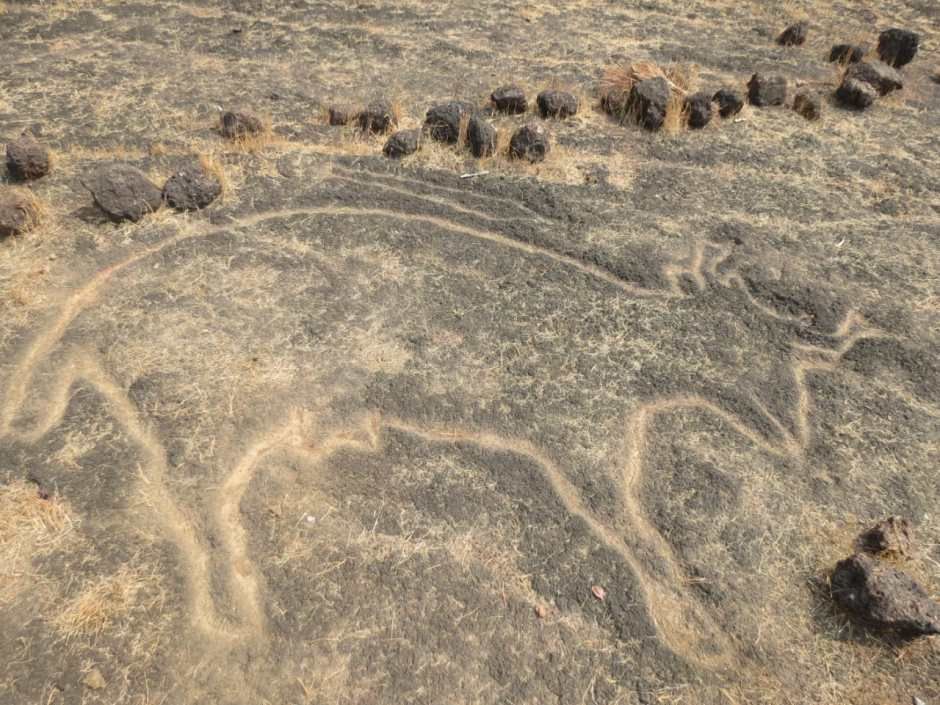

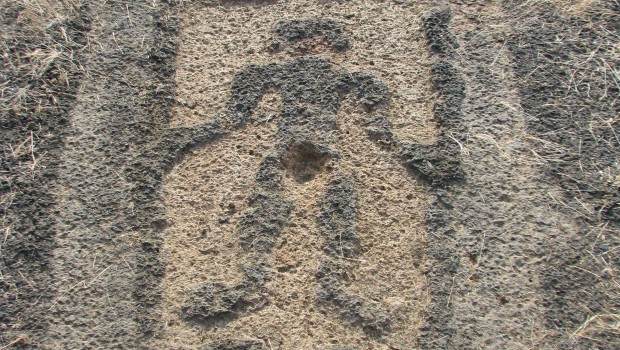

 Master of Animals?
Master of Animals? 



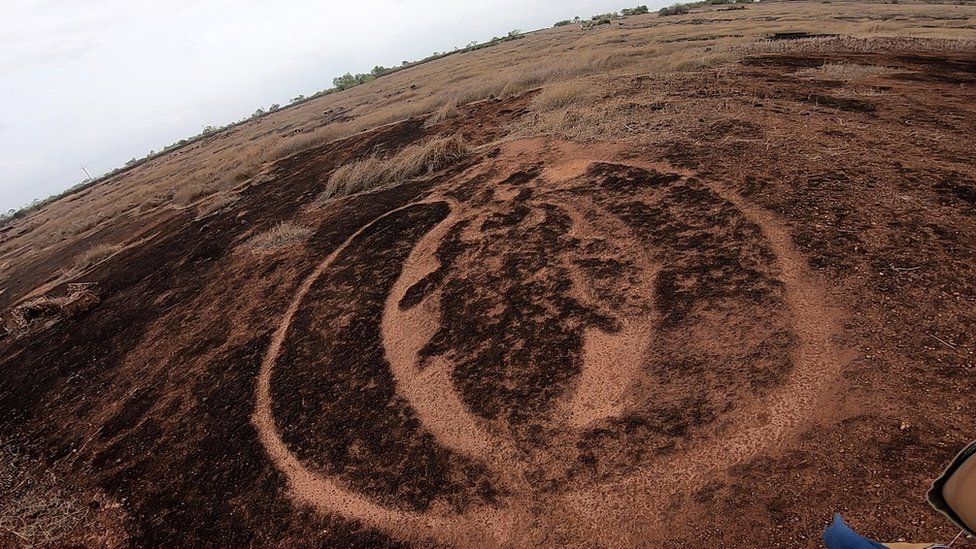
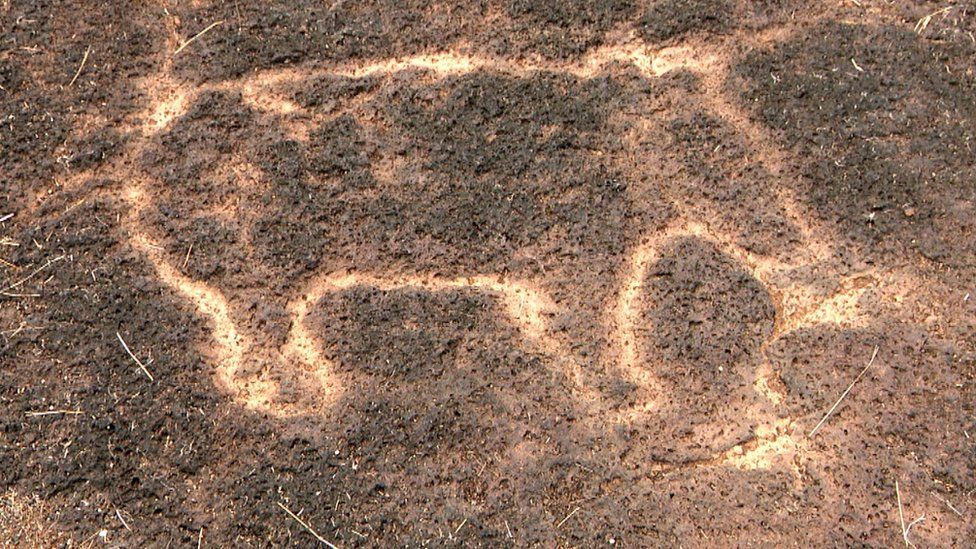
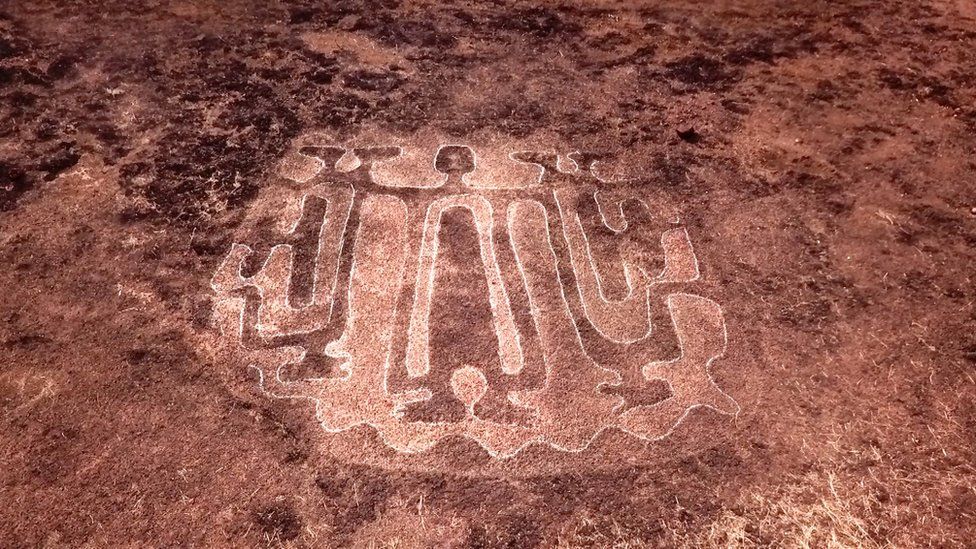

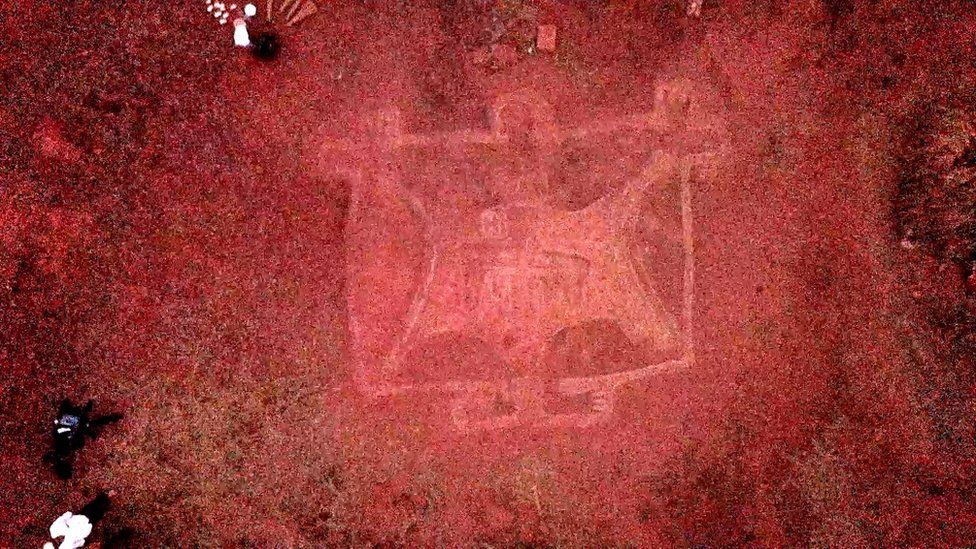










































































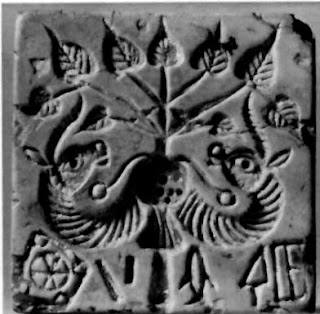
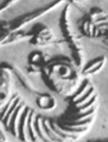







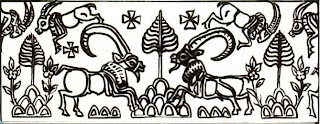
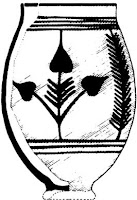




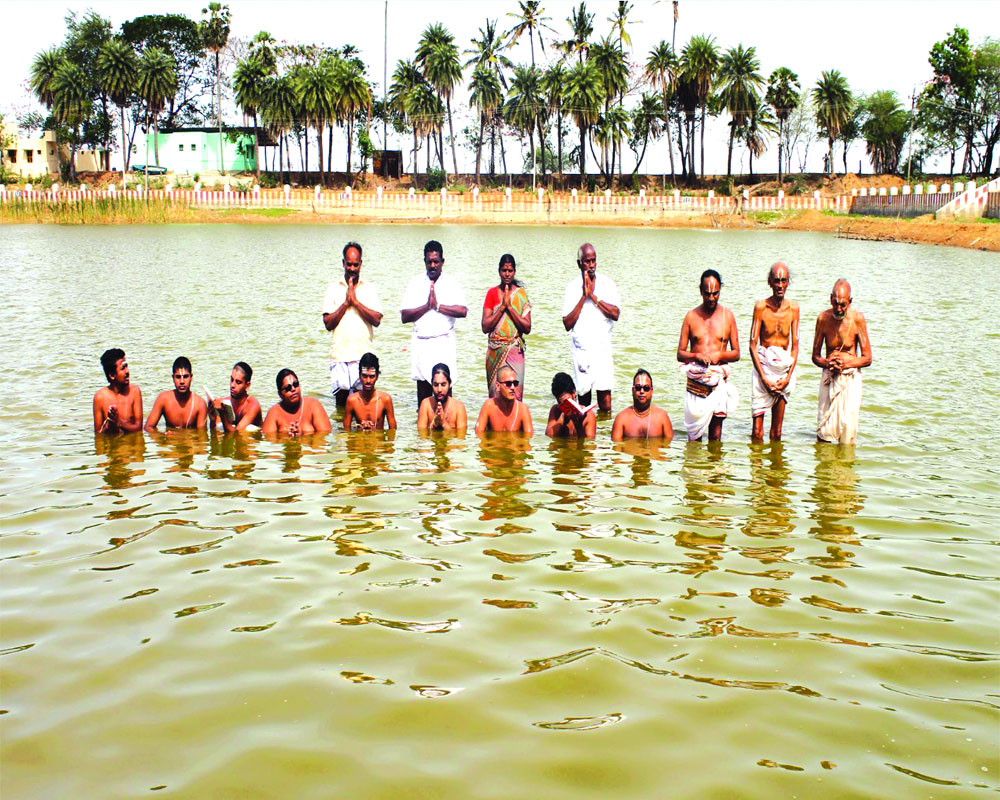


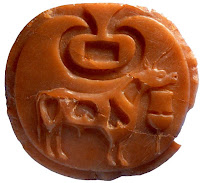
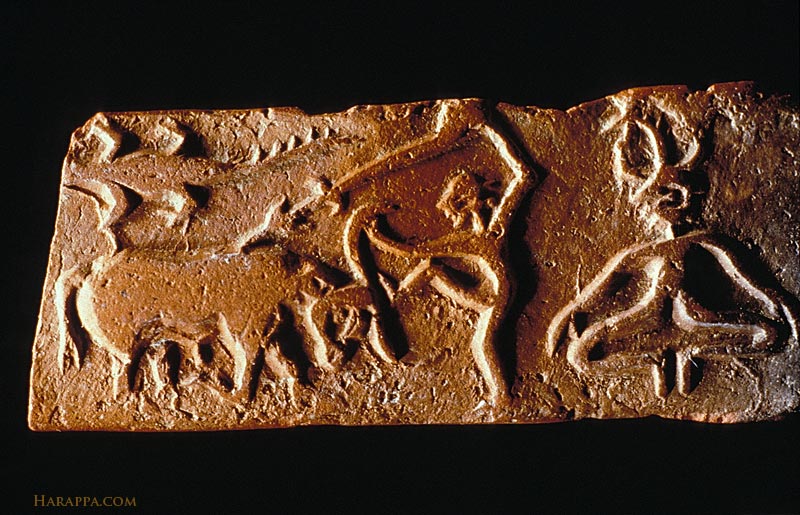
 One side of a molded tablet m 492 Mohenjo-daro (DK 8120, NMI 151. National Museum, Delhi. A person places his foot on the horns of a buffalo while spearing it in front of a cobra hood. FS 99 Person throwing a spear at a sho rt·ho rned bull and placing o ne foot on the head of the animal; a hooded serpe nt at L.
One side of a molded tablet m 492 Mohenjo-daro (DK 8120, NMI 151. National Museum, Delhi. A person places his foot on the horns of a buffalo while spearing it in front of a cobra hood. FS 99 Person throwing a spear at a sho rt·ho rned bull and placing o ne foot on the head of the animal; a hooded serpe nt at L.
 FS 105 Person grappling with two tigers standing on either side of him (her?) and rearing on their hindlegs
FS 105 Person grappling with two tigers standing on either side of him (her?) and rearing on their hindlegs
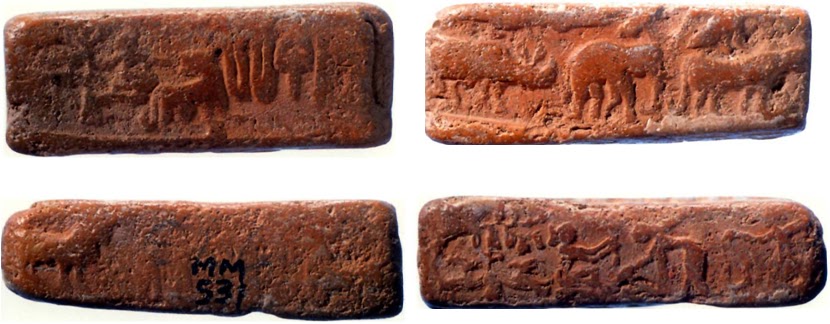
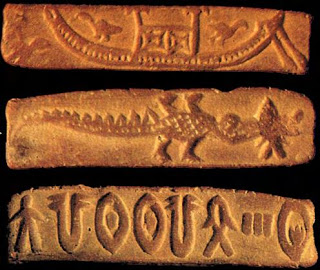































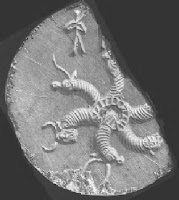 FS 62 Composite mo tif consist ing of six heads of animals viz.thnse of unicorn . short-horned bull. antelope. tiger and of two ulher uncertain animals radiating oulwarth. from a ring. (Frequency: 62 M Corpus)
FS 62 Composite mo tif consist ing of six heads of animals viz.thnse of unicorn . short-horned bull. antelope. tiger and of two ulher uncertain animals radiating oulwarth. from a ring. (Frequency: 62 M Corpus) 






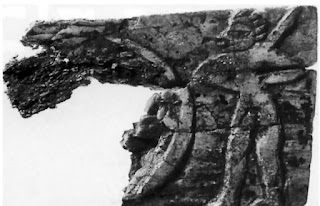

 m008 "
m008 "


 "First Unicorn seals.
"First Unicorn seals.  Source: Chapter Ten - Understanding Indus Seal-Carving Traditions: A Stylistic and Metric Approach
Source: Chapter Ten - Understanding Indus Seal-Carving Traditions: A Stylistic and Metric Approach









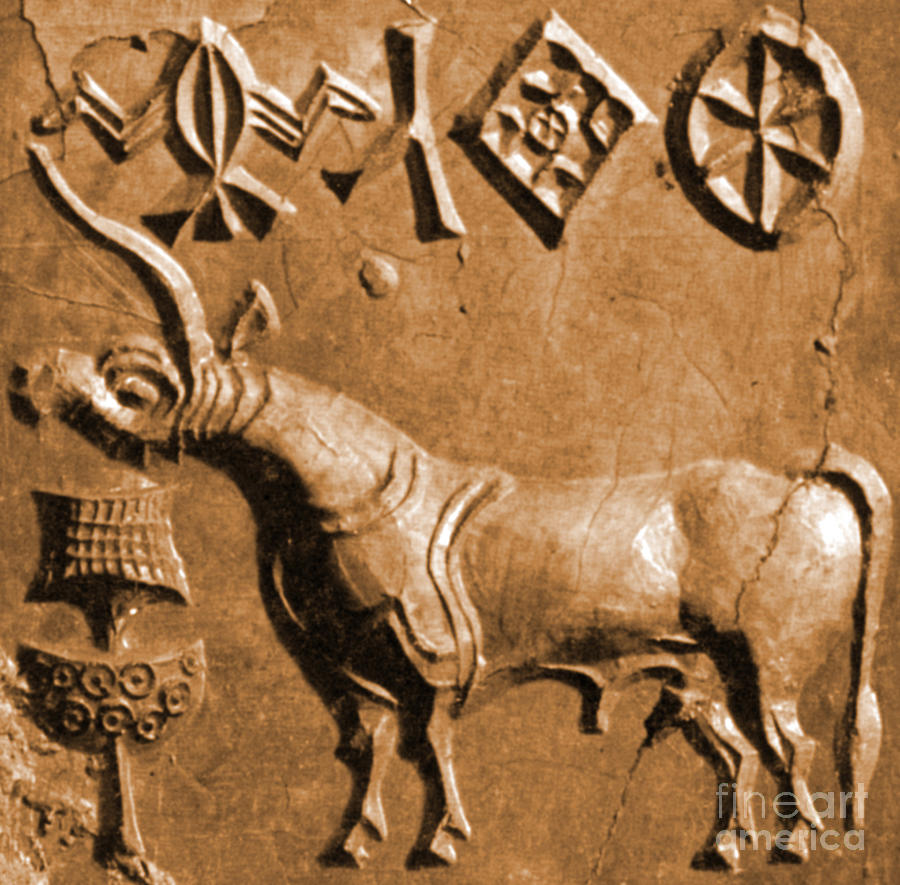


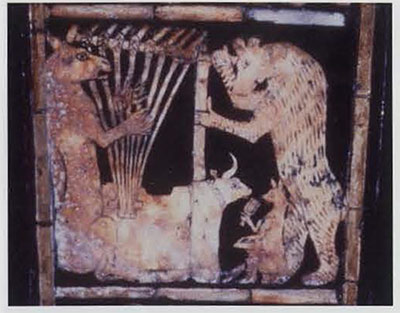
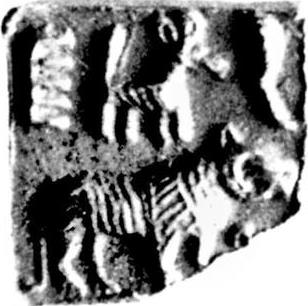 m290 Mohenjo-daro seal. Decipherment: kola 'tiger' Rebus; kolle 'blacksmith' kol 'working in iron' kole.l 'smithy, temple' kolimi 'smithy, forge' PLUS pattar 'trough' Rebus: pattar 'guild of goldsmiths'. panja 'feline paw' rebus: panja 'kiln, furnace'
m290 Mohenjo-daro seal. Decipherment: kola 'tiger' Rebus; kolle 'blacksmith' kol 'working in iron' kole.l 'smithy, temple' kolimi 'smithy, forge' PLUS pattar 'trough' Rebus: pattar 'guild of goldsmiths'. panja 'feline paw' rebus: panja 'kiln, furnace'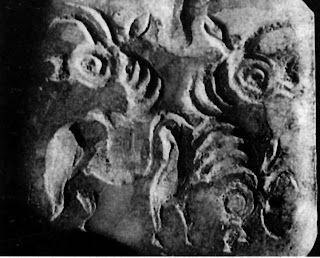



 Hittite Archer and Chariot - Late Hittite sculpture on orthostat. The Hittites were renowned charioteers. They developed a new chariot design, which had lighter wheels, with less spokes. The Battle of Kadesh in 1299 BC is likely to have been the largest chariot battle ever fought, involving some five thousand chariots. (
Hittite Archer and Chariot - Late Hittite sculpture on orthostat. The Hittites were renowned charioteers. They developed a new chariot design, which had lighter wheels, with less spokes. The Battle of Kadesh in 1299 BC is likely to have been the largest chariot battle ever fought, involving some five thousand chariots. ( 



 Fins.Willayat of Denk.
Fins.Willayat of Denk.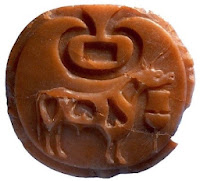
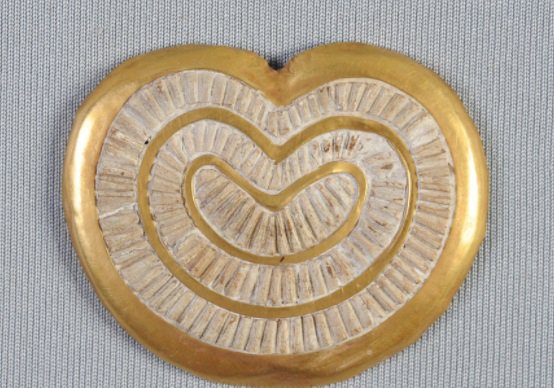 m1656 Pectoral.
m1656 Pectoral. 









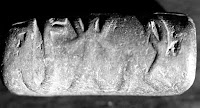 Stone seal. h179. National Museum, India. Carved seal. Scan 27418 Tongues of flame decorate the flaming pillar, further signified by two 'star' hieroglyphs on either side of the bottom of the flaming arch.
Stone seal. h179. National Museum, India. Carved seal. Scan 27418 Tongues of flame decorate the flaming pillar, further signified by two 'star' hieroglyphs on either side of the bottom of the flaming arch. Santali glosses.
Santali glosses.



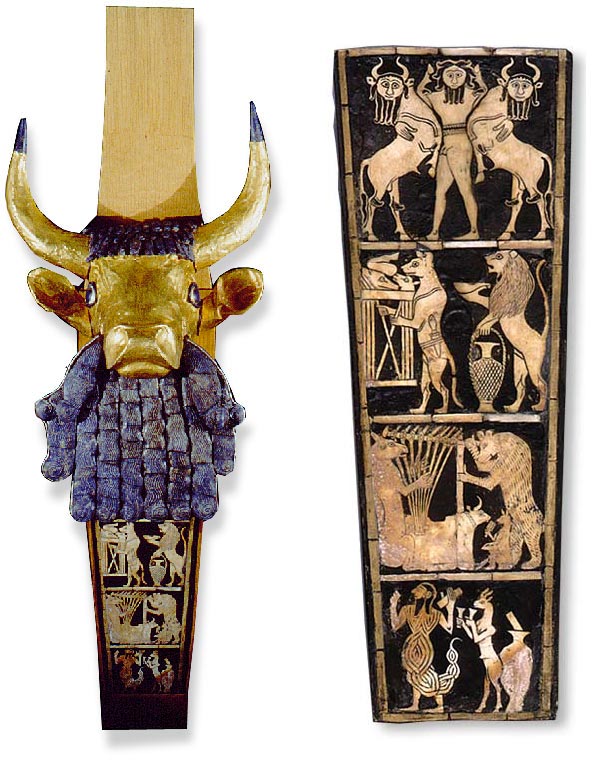



































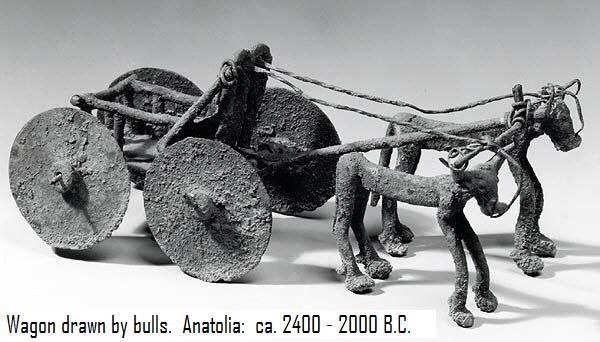


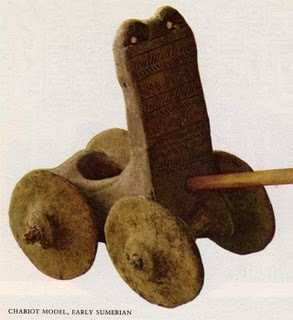
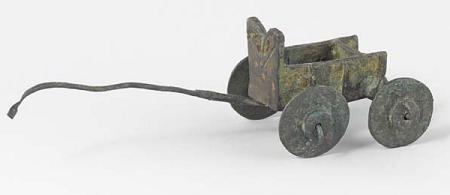
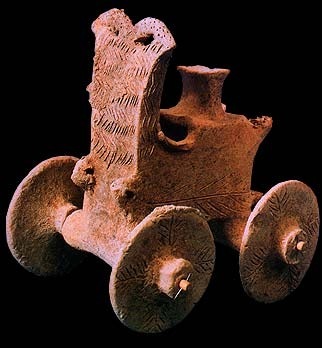
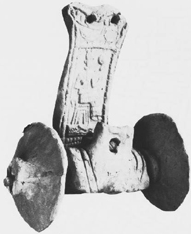




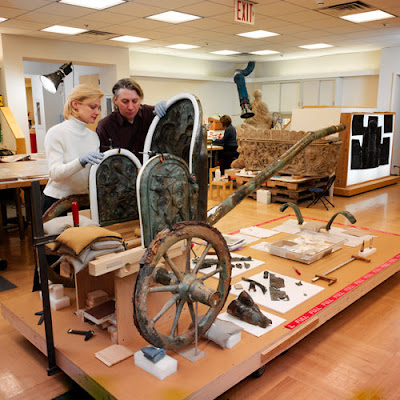 Etruscan chariot. 530 BCE Met Museum.
Etruscan chariot. 530 BCE Met Museum.
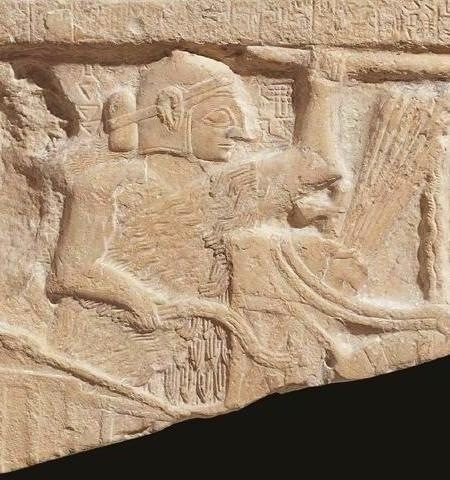
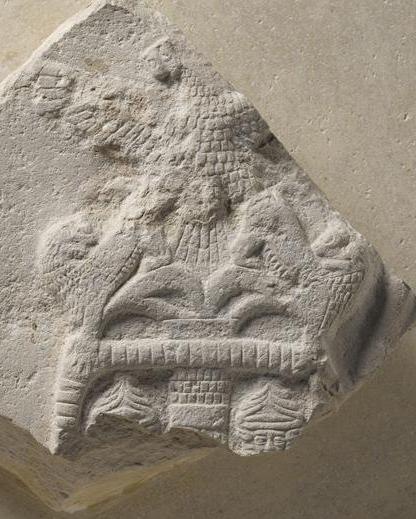
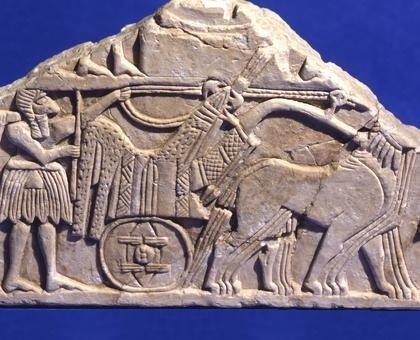
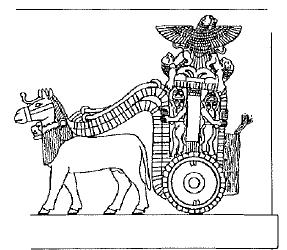 See treaded tires on a
See treaded tires on a 
 "Peace," detail of Standard of Ur, showing
"Peace," detail of Standard of Ur, showing 






















































































































 Daimabad, bronze animals on wheels
Daimabad, bronze animals on wheels









 Persian onagers.
Persian onagers.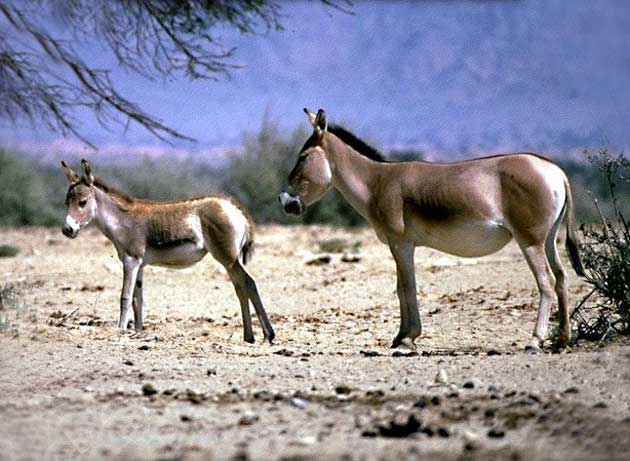




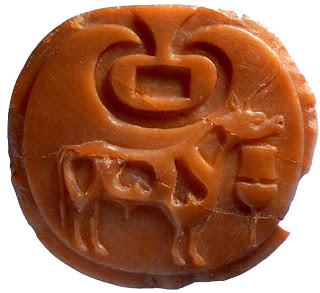

 Herringbone pattern.
Herringbone pattern.





